Research conducted by Answers in Genesis staff scientists or sponsored by Answers in Genesis is funded solely by supporters’ donations.
Abstract
Creationists recognize that animals were created according to their kinds, but there has been no comprehensive list of what those kinds are. As part of the Answers in Genesis Ark Encounter project, research was initiated in an attempt to more clearly identify and enumerate vertebrate kinds that were present on the Ark. In this paper, using methods previously described, 196 putative bird kinds are identified. Due to the limited information available and the fact that avian taxonomic classifications shift, this should be considered only a rough estimate.
Keywords: Ark, kinds, created kinds, baraminology, birds
Introduction
As part of the Ark Encounter project, Answers in Genesis initiated and funded research in an attempt to more clearly identify and enumerate the vertebrate kinds that were present on the Ark. In an initial paper, the concept of biblical kinds was discussed and a strategy to identify them was outlined (Lightner et al. 2011). Some of the key points are noted below.
There is tremendous variety seen today in animal life as creatures have multiplied and filled the earth since the Flood (Genesis 8:17). In order to identify which modern species are related, being descendants of a single kind, interspecific hybrid data is utilized. When hybrid data is lacking, a cognitum approach is preferred; this identifies natural groupings based on human cognitive senses. Generally the cognitum at the family level (which is usually fairly strong) is preferred when hybrid data is lacking, though obvious cognita surrounding this level are noted.
Another method that has been used to identify baramins (created kinds) is statistical baraminology. The methods of baraminic distance correlation (BDC) and multidimensional scaling (MDS) are discussed in more detail elsewhere (Wood 2008). Though they are important tools, Lightner et al. (2011) did not consider them as reliable as hybrid data and a cognitum approach on extant species. Results from statistical baraminology studies will be noted here where applicable.
Previous research has provided an initial estimation of mammal and amphibian kinds (Hennigan 2013a; Hennigan 2013b; Lightner 2012). This paper will focus on identifying extant bird kinds. There are over 10,000 living species of birds, making them the most speciose class of vertebrates descended from those preserved on the Ark. There is a large amount of hybrid data available for birds (McCarthy 2006). There are several examples in well-studied species where hybrid data connects several large, diverse families (within the orders Galliformes, Charadriiformes, and Passeriformes).
As in mammals and amphibians, the state of avian taxonomy is in flux. Despite the ideal of neatly nested hierarchies in taxonomy, it seems groups of birds are repeatedly “changing nests.” This is partially because where an animal is placed depends on which characteristics one chooses to consider. While many had thought that molecular data would resolve these issues, in some cases it has exacerbated them. For this estimate of the avian Ark kinds, the taxonomic scheme presented online by the International Ornithologists’ Union (IOU) was used (Gill and Donsker 2012a, 2012b and 2013). This list includes information on extant and some recently extinct species. Any birds known only from the fossil record will not be included in this analysis.
Order Tinamiformes

Source: Wikipedia http://www.en.wikipedia.org.
Fig. 1. Crypturellus cinereus.
Tinamidae (The Tinamous kind)
This single family order comprises nine genera and 47 species. Superficially they appear chicken-like. It is debated whether they are more closely related to chickens (Galliformes) or large flightless birds known as ratites (Howard 2003a). They have a palaeognathous palate, as do ratites. However, unlike ratites, they have a keel on the sternum and fully developed wings so they can fly (Handbook of the Birds of the World Alive). Considering this controversy, the family/order seems a natural place to postulate the level of the kind.
Order Struthioniformes
Struthionidae (The Ostrich kind)
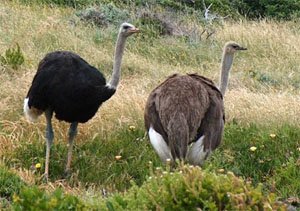
Source: Wikipedia http://www.en.wikipedia.org.
Fig. 2. Struthio camelus.
This family contains a single genus with two species (Gill and Donsker 2012a). They are the largest living birds. Although flightless, they are good runners and once inhabited open areas all over Africa and in the Middle East (Roberson 2012). From a cognitum standpoint, ostriches fit in with other ratite birds such as rheas and emus. These physical similarities were the basis of earlier taxonomists grouping ratities together. Later work suggested they were not as closely related, so many similarities were attributed to convergent evolution (Handbook of the Birds of the World Alive). The only hybrid data are from crosses between the two species of ostrich (McCarthy 2006). Since other ratites currently occupy different orders in the IOU classification scheme and there is no hybrid data linking these orders, the level of the kind will be considered the family/order for now.
Order Rheiformes
Rheidae (The Rhea kind)

Source: Wikipedia http://www.en.wikipedia.org.
Fig. 3. Rhea americana.
This family also contains a single genus with two species (Gill and Donsker 2012a). These tall, long-legged, flightless birds are excellent runners. They live in South America, usually in open grasslands (Cholewiak 2003a). Despite the fact that they group with other ratites from a cognitum perspective, they are not combined with them here. The only hybrid data is between the two species of rhea (McCarthy 2006). Sibley and Monroe (1990) place rheas in an infraorder beside the ostrich based on DNA-DNA hybridization studies, which give an estimate of DNA similarity between species. Casuariiformes is reduced to a suborder beside these two groups, and Tinamiformes is kept in a separate order beside these in their taxonomy. So there is a fair amount of similarity among these first four orders on the DNA level too. Since we don’t know how to assess DNA similarity in a way that is helpful to identify kinds, the estimate is kept at the family/order level.
Order Casuariiformes
Casuariidae (The Cassowary kind)

Source: Wikipedia http://www.en.wikipedia.org.
Fig. 4. Casuarius unappendiculatus.
A single genus with three species is recognized in this family (Gill and Donsker 2012a). These large ratites are found in the Australo-Papuan region. They live in the rainforest. They are considered closely related to emus, and are sometimes classified in the same family. They are relatively common in the fossil record. There is a fossil believed to be intermediate between cassowaries and emus (Cholewiak 2003b). Given this, the level of the kind could actually be higher, at the order or possibly above. Since hybrid data is lacking, the kind will be considered at the family level to avoid a bias that will underestimate the number of kinds on the Ark.
Dromaiidae (The Emu kind)

Source: https://commons.wikimedia.org/w/index.php?search=Emu_1_-_Tidbinbilla.jpg
Fig. 5. Dromaius novaehollandiae.
This family is monotypic, comprised of a single species (Gill and Donsker 2012a). This large ratite is native to Australia. It inhabits grassy areas or open forests. These shaggy birds spend most of their time foraging, consuming grass and plants. They will also eat large quantities of insects when they are available (Roberson 2012). This family is represented in the fossil record and several species went extinct in the early nineteenth century (Handbook of the Birds of the World Alive).
Order Apterygiformes
Apterygidae (The Kiwi kind)

Source: Wikipedia http://www.en.wikipedia.org.
Fig. 6. Apteryx australis.
This family is comprised of a single genus with five species (Gill and Donsker 2012a). There is hybrid data linking three of these species (McCarthy 2006). Kiwis are unusual flightless birds which live in New Zealand. These nocturnal birds stay in a burrow during the day, and come out to forage at night (Roberson 2012). These ratities are believed to be more closely related to the extinct moas (Handbook of the Birds of the World Alive).
Order Galliformes
(The Landfowl kind)
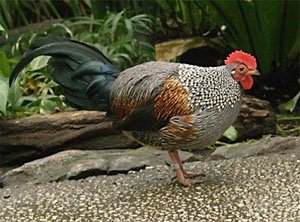
Source: Wikipedia http://www.en.wikipedia.org.
Fig. 7. Gallus sonneratii.
Landfowl, which include chickens, turkeys, and pheasants, are comprised of five families with 299 species (Gill and Donsker 2012a). Four of these families (Cracidae, Numididae, Odontophoridae, and Phasianidae) are united by hybrid data (McCarthy 2006). The fifth family, Megapodidae, has long been considered more closely allied with Cracidae than either of these two families are with the other three families (Wetmore 1930). In fact, Sibley and Monroe (1990) list Megapodidae and Cracidae in a separate order from the others based on DNA-DNA hybridization studies. Thus, with Cracidae being united with the other three families, it appears that all five families were derived from a single created kind.
Using statistical baraminology techniques, a large data set of mostly osteologic characters was analyzed to assess the level of the kind within this order. The results suggested that there were four distinct groups (i.e. potential baramins): Megapodidae, Cracidae, Numididae, and the remaining species grouped in the superfamily Phasianoidea (McConnachie and Brophy 2008). This discrepancy between hybrid data and the results of statistical baraminology techniques is an important reminder that the latter, though valuable in helping to estimate the level of the kind, should be considered tentative.
Order Anseriformes
Anhimidae (The Screamer kind)

Source: http://tolweb.org.
Fig. 8. Chauna torquata.
This family comprises two genera and three species. Overall the body is goose-like, but the neck is short and topped with a rather small chicken-like head. The webbing in the feet is shallow. Historically there has been some dispute over where to place this group (Howard 2003b). There is hybrid data between the two species in the genus Chauna, but none between this family and any others (McCarthy 2006). Thus it seems best to tentatively consider the kind at the family level.
Anseranatidae (The Magpie Goose kind)
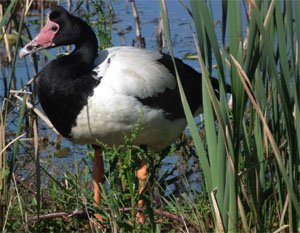
Source: Wikipedia http://www.en.wikipedia.org.
Fig. 9. Anseranas semipalmata.
There is a single species in this family. The magpie goose is found in Australia and New Guinea. They swim and wade in the wet grasslands and swamps by the coast. Their feet are only partially webbed (Wilber 2008). The magpie goose has some features that seem intermediate between screamers and the family Anatidae (Roberson 2012). In the past it had been classified with Anatidae (Wetmore 1930). Sibley and Monroe (1990) place the family closer to Anhimidae based on their DNA studies. Although they seem to fit in the same cognitum as ducks, geese, and swans, they are considered separate here so as to avoid possibly underestimating the kinds on the Ark.
Anatidae (The Duck kind)

Source: Wikipedia http://www.en.wikipedia.org.
Fig. 10. Dendrocygna autumnalis.
This family comprises 49 genera and 172 species (Gill and Donsker 2012a). In addition to a diverse array of ducks, this family includes geese and swans. Previous statistical baraminologic analysis seemed to indicate three groups within this family. Though this was clearly seen in the BDC analysis, the tetrahedral shape of the MDS calls this into question (Wood 2008). There has been debate about the relationship of taxa within this group (Howard 2003c). However, there is hybrid data that connects all subfamilies (McCarthy 2006). Therefore the level of the kind appears to be at least at the family level.
Order Gaviiformes
Gaviidae (The Loon kind)

Source: Wikipedia http://www.en.wikipedia.org.
Fig. 11. Gavia pacifica.
The five species of loons all belong to a single genus (Gill and Donsker 2012a). They appear similar to ducks as they swim on the water, except for their dagger-like bill. They are specialized fish eaters. On land they are clumsy because their feet are set so far back on their body (Roberson 2012). Natural hybridization has been reported between four of these species; there is an inferred hybrid involving the fifth species (McCarthy 2006).
Order Sphenisciformes
Spheniscidae (The Penguin kind)

Source: Wikipedia http://www.en.wikipedia.org.
Fig. 12. Pygoscelis papua.
This family comprises 18 species in six genera (Gill and Donsker 2012a). There are a number of extinct genera and species of penguins which show a greater diversity in size and shape than those alive today. Penguins are unique in being both flightless and aquatic (Roberson 2012). Natural hybridization has been recorded between several different species with others in the same genus (McCarthy 2006). There is a strong cognitum at the family level and previous statistical baraminology studies strongly suggest all extant penguins belong to the same kind (Wood 2008).
Order Procellariiformes
A strong cognitum appears at this level. Based on their DNA-DNA hybridization studies, Sibley and Monroe (1990) place this order as a family with the following families grouped into three subfamilies. The diving petrels are placed in the petrels. In their scheme loons (Gaviidae), penguins (Spheniscidae) and frigatebirds (Fregatidae) are placed nearby. In other taxonomies frigatebirds are not placed near these families (Alderfer 2005; Gill and Donsker 2012a) and penguins seem to fall in their own cognitum, strongly suggesting these latter two groups are distinct kinds. Despite these hints that the level of the kind may be at the order Procellariiformes, it will be placed below this at the family level to avoid possibly underestimating the number of kinds.
Diomedeidae (The Albatross kind)

Source: Wikipedia http://www.en.wikipedia.org.
Fig. 13. Phoebastria albatrus.
There are four genera and 21 species of albatrossses (Gill and Donsker 2012a). The albatross has a thick body with long narrow wings. They have large webbed feet and spend much time soaring in the open ocean (Alderfer 2005). Two of the genera have some interspecific hybrid data (McCarthy 2006).
Procellariidae (The Petrel kind)

Source: Wikipedia http://www.en.wikipedia.org.
Fig. 14. Puffinus nativitatis.
This family is comprised of 14 genera and 90 species (Gill and Donsker 2012a). Petrels and shearwaters are similar in many was to the albatross. They also have heavy bodies, long narrow wings, and webbed feet. They are also generally found out at sea. They differ from the albatross in having a single tube on the upper ridge of their bill (culmen). The albatross has a single tube on each side of its culmen (Alderfer 2005). They certainly seem to be in the same cognitum as the albatross. Interspecific hybrid data is found within some genera, and hybrids have been inferred between some genera. However, no hybrid data links this family with the albatrosses (McCarthy 2006).
Hydrobatidae (The Storm Petrel kind)

Source: Wikipedia http://www.en.wikipedia.org.
Fig. 15. Oceanodroma furcata.
There are seven genera and 24 species of storm petrels (Gill and Donsker 2012a). Storm petrels are smaller aerial seabirds. Like other members of this order, they have special tubes on their bills which remove the salt from the seawater they drink. They are proportioned a bit differently than the previous two families (Roberson 2012).
Pelecanoididae (The Diving Petrel kind)

Source: Wikipedia http://www.en.wikipedia.org.
Fig. 16. Pelecanoides garnotii.
This monogeneric family has four species (Gill and Donsker 2012a). They are small stocky seabirds with short wings that excel in swimming and diving, rather than in soaring. In some ways they resemble the unrelated auks (Charadriiformes: Alcidae). This is attributed to convergent evolution (Roberson 2012).
Order Podicipediformes
Podicipediformes (The Grebe kind)
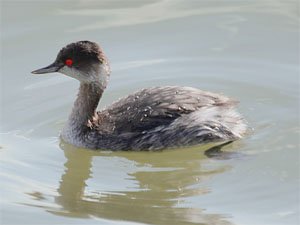
Source: Wikipedia http://www.en.wikipedia.org.
Fig. 17. Podiceps nigricollis.
There are six genera and 23 species of grebes (Gill and Donsker 2012a). Grebes are well represented in the fossil record and are not considered closely related to other birds. They are excellent divers with lobed toes on legs set far back on the body. They are clumsy on land and are rarely seen out of the water (Roberson 2012). There is some hybrid data including an intergeneric cross between Podilymbus podiceps and Tachybaptus ruficollis (McCarthy 2006).
Order Phoenicopteriformes
Phoenicopteridae (The Flamingo kind)

Source: Wikipedia http://www.en.wikipedia.org.
Fig. 18. Phoenicopterus ruber.
There are six species of flamingos in one genus (Gill and Donsker 2012a). They are very distinctive with their proportionally long legs and neck as well as their pink plumage. They also have a distinctive bill that is bent in the center and used to strain algae, diatoms, and aquatic invertebrates (Alderfer 2005). There is hybrid data connecting five of the six species (McCarthy 2006).
Order Phaethontiformes
Phaethontidae (The Tropicbird kind)

Source: Wikipedia http://www.en.wikipedia.org.
Fig. 19. Phaethon rubricauda.
This family comprises three species in a single genus (Gill and Donsker 2012a). They live out at sea, have a distinctive long central tail streamer as adults, and dive for fish and other prey. The feet are webbed and the legs are far back on the body, making them clumsy when walking. They rarely glide, but fly with rapid wing beats (Alderfer 2005).
Order Ciconiiformes
Ciconiidae (The Stork kind)

Source: Wikipedia http://www.en.wikipedia.org.
Fig. 20. Mycteria leucocephala.
This family has 19 species in six genera (Gill and Donsker 2012a). Storks are large wading birds. Though superficially similar to some other wading birds, some recent taxonomists suggest they are more closely related to New World vultures (Cathartidae). Hybrids have been reported within the large genus Ciconia as well as between Leptoptilos javanicus and Mycteria leucocephala (McCarthy 2006). The species involved in the intergeneric cross are from two different tribes (Roberson 2012). Given all these factors, the order/family level seems to be the level of the kind.
Order Pelecaniformes
Threskiornithidae (The Ibis kind)

Source: Wikipedia http://www.en.wikipedia.org.
Fig. 21. Platalea regia.
This family is comprised of 13 genera and 35 species (Gill and Donsker 2012a). Ibises and spoonbills are wading birds that can be easily distinguished from each other by bill shape, coloration, and foraging patterns. Despite the distinctiveness of each, the intergeneric hybrid data, which links four of the genera in this family, clearly shows they are related (McCarthy 2006).
Ardeidae (The Heron kind)

Source: Wikipedia http://www.en.wikipedia.org.
Fig. 22. Ardea herodias.
There are 72 species in 19 genera in this family (Gill and Donsker 2012a). These distinctive birds, which include egrets and bitterns, have a fossil record going back to the lower Eocene. Most are adapted to wading and preying on fish (Alderfer 2005; Roberson 2012). A statistical baraminologic analysis was done and revealed two groups. The bittern subfamily, Botaurinae, formed one group. The remaining herons and the outgroup formed the second. Members of the outgroup are largely from the ibis family (Threskiornithidae) and stork family (Ciconiidae), although the flamingo was included too. Two possible interpretations were suggested. Either bitterns make up a holobaramin (entire created kind) or the level of the kind appears to be above the level of the order (Wood 2008).
At one time bitterns were in one subfamily and all other species were in another. However, now four subfamilies are recognized, and none is considered more closely related to another than to the remaining ones. Further, it is not uncommon for the ibis and the heron to be placed in the same order as storks. Sometimes even the flamingo has been considered to be in the same order (McKilligan 2005). Thus a higher level for the kind may not be that implausible. Nevertheless, herons have some distinctive features so there is a strong cognitum at the family level. Therefore the level of the kind is placed here to be conservative.
Scopidae (The Hamerkop kind)

Source: Wikipedia http://www.en.wikipedia.org.
Fig. 23. Scopus umbretta.
The single species in this family lives in sub-Saharan Africa and has unique habits and behavior. It has a few features reminiscent of herons. It has an odd mix of other characters which are similar to the shoebill, flamingos, and storks. It has ectoparasites that are otherwise found only in plovers. Given this, its origin and relationship to other birds are considered unclear (Roberson 2012), so it is considered here to belong to its own kind.
Balaenicipitidae (The Shoebill kind)

Source: Wikipedia http://www.en.wikipedia.org.
Fig. 24. Balaeniceps rex.
This single species is also found in sub-Saharan Africa. It has been called the Whale-headed stork, though it flies with its neck retracted like a heron. There is skeletal and biochemical evidence suggesting it is more closely related to pelicans (Roberson 2012). Sibley and Monroe (1990) list it as a subfamily in Pelecanidae. Here it is considered to belong to a unique created kind since it is currently placed as a distinct family.
Pelecanidae (The Pelican kind)
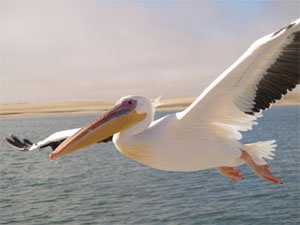
Source: Wikipedia http://www.en.wikipedia.org.
Fig. 25. Pelecanus onocrotalus.
All eight species of pelicans belong to a single genus (Gill and Donsker 2012b). They are distinctive birds with their long, hooked bills and large gular pouches (Alderfer 2005). They fill their beaks with huge gulps of water, strain out the liquid, and eat the remaining fish or squid. They are represented in the fossil record (Roberson 2012). The strong cognitum makes the family a natural place to infer the level of the kind.
Order Suliformes
Fregatidae (The Frigatebird kind)

Source: Wikipedia http://www.en.wikipedia.org.
Fig. 26. Fregata magnificens.
There are five species in a single genus in this family (Gill and Donsker 2012b). Frigatebirds are excellent aerialists. They have a light build, long, angular wings and a long, deeply forked tail. These tropical seabirds can glide for great distances over the water. Their long bill is deeply hooked at the tip. The males can greatly inflate their red gular pouch during courtship (Alderfer 2005). There is a strong cognitum at this level, suggesting that this is the level of the kind.
Phalacrocoracidae (The Cormorant kind)

Source: Wikipedia http://www.en.wikipedia.org.
Fig. 27. Phalacrocorax carbo.
This family comprises three genera and 41 species (Gill and Donsker 2012b). Some authors list all species in a single genus. These long-necked diving birds have long, heavy bodies, stiff tails, and long bills which are hooked at the tip. They lack the waterproofing oil of some birds, and so must perch with their wings spread after a diving bout (Alderfer 2005; Roberson 2012). For convenience, the level of the kind is defaulted to the family.
Anhingidae (The Anhinga kind)

Source: Wikipedia http://www.en.wikipedia.org.
Fig. 28. Anhinga rufa.
This family comprises four species in a single genus (Gill and Donsker 2012b). They resemble slender, long-tailed cormorants and are considered closely related to them. The bill is pointed. The neck is kinked back much like a heron, which allows for quick strikes on prey. They have short legs and large webbed feet. Since they lack hybrid data uniting them with cormorants, the level of the kind is left at the family level.
Order Accipitriformes
Cathartidae (The New World Vulture kind)

Source: Wikipedia http://www.en.wikipedia.org.
Fig. 29. Carthartes aura.
This family is comprised of seven species in three genera (Gill and Donsker 2012b). Like their Old World counterparts, they have hooked bills, naked heads and feed on carrion. In fact, there is such a strong cognitum among vultures that it would be very natural to group them together in the same kind. However, detailed anatomical comparisons, as well as some behavioral similarities suggest the New World vultures have much in common with storks. DNA hybridization studies also seem to support this. Therefore, these similarities among Old and New World vultures are now attributed to convergent evolution (Alderfer 2005; Handbook of the Birds of the World Alive; Roberson 2012).
This brings up an important point, both the cognitum and statistical baraminology assume that kinds have retained their distinctiveness as creatures have reproduced and filled the earth. There is no biblical basis for asserting that this must be true. Convergent evolution can be a reasonable explanation for similarities in the creation model. It involves similar adaptive changes to a particular environmental niche, either within a kind (as different populations adapted in the same basic way) or between members of different kinds. In fact, convergent evolution fits a bit better in the creation model. Evolution (in the molecules-to-man sense) is supposed to be the result of chance processes, so there is no reason to suspect that creatures would adapt in the same ways. This would be especially true as they diverged, since previous changes should limit future options for change. With a Creator who intends for the earth to be inhabited, it is not unreasonable to postulate that creatures were designed to be able to change. This provides a logical basis for why the same types of changes can occur, whether two creatures belong to the same kind or not.
It is also notable that there is no consensus on how members of Accipitriformes and Falconiformes are related to other birds. In fact, the fossil record fails to support common ancestry of the different families in these orders, leaving evolutionists open to the possibility of separate ancestry with similarities attributable to convergent evolution (Handbook of the Birds of the World Alive). With regard to vultures, given the current information, it appears that New World vultures are distinct from Old World vultures. They also don’t share a strong enough cognitum with storks to place the level of the kind above the family level. Therefore the family seems best place to designate the kind for now.
Sagittariidae (The Secretarybird kind)

Source: Wikipedia http://www.en.wikipedia.org.
Fig. 30. Sagittarius serpentarius.
There is a single extant species in this family. This distinctive bird of the African plains has always been placed in its own family, and sometimes in its own order. It shares some features with birds of prey, and thus is classified near them in the IOU taxonomy. In other respects the secretarybird is similar to storks. Some have suggested a relationship with cranes or other members of Gruiformes. The secretarybird is nearly four feet tall. It has powerful legs, the top portion of which is covered with black feathers, giving it the appearance of wearing breeches (Roberson 2012, Handbook of the Birds of the World Alive). Based on its unique features and the fact that there is no other group it is clearly related to, the level of the kind is placed at the family.
Pandionidae (The Osprey kind)
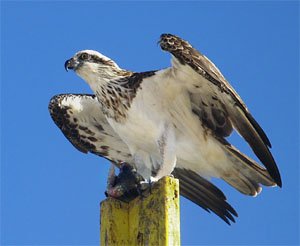
Source: Wikipedia http://www.en.wikipedia.org.
Fig. 31. Pandion haliaetus.
There are two species of osprey which are both in a single genus (Gill and Donsker 2012b). They are sometimes referred to a “fish hawks” as they eat almost exclusively fish. They are distinctive in a number of ways. They have a reversible outer toe, spiny foot pads to help grip slippery fish, and nasal valves that close underwater. They also are well represented in the fossil record (Roberson 2012). It has been suggested that this family has undergone little speciation because they are long distance migrants, which allows for more interbreeding between populations. Thus they don’t experience the isolation that is thought to contribute to speciation (Handbook of the Birds of the World Alive).
Accipitridae (The Hawk kind)
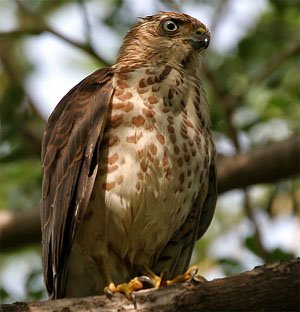
Source: Wikipedia http://www.en.wikipedia.org.
Fig. 32. Accipiter badius.
This large family is comprised of 256 species in 65 genera. It not only includes hawks, but also kites, harriers, eagles, and Old World vultures (Gill and Donsker 2012b). These birds have excellent eyesight, strong feet with curved talons to grab prey, and a hooked beak. Some species have long, wide rounded wings and excel at soaring. Others have narrower wings and longer tails for maneuverability (Alderfer 2005). The Old World vultures can be argued to have a different cognitum than others in this family. However, taxonomically there are no subfamilies in Accipitridae, implying that the birds are considered closely related. Therefore, despite the large size of the family, they are considered a single kind here.
Order Falconiformes
Falconidae (The Falcon kind)

Source: Wikipedia http://www.en.wikipedia.org.
Fig. 33. Falco berigora.
Falcons and caracaras comprise 67 species in 11 genera (Gill and Donsker 2012b). Despite the varied morphology and lifestyles of these birds, the family seems clearly defined by six or more morphological characteristics. There is considerable difference of opinion on how birds within the family are related to each other (Handbook of the Birds of the World Alive). Since this is a single family order, it seems a reasonable place to designate the kind. Statistical baraminology analysis of this group involved a dataset that only used characters of the syrinx. Members of one subfamily grouped together strongly. The other subfamily was more ambiguous and some members grouped more strongly with outgroup birds. It was thus concluded that the dataset revealed more about the structure of the syrinx in these birds rather than their baraminic status (Wood 2008).
Order Otidiformes
Otididae (The Bustard kind)

Source: Wikipedia http://www.en.wikipedia.org.
Fig. 34. Ardeotis kori.
This family comprises 11 genera and 26 species (Gill and Donsker 2012b). They have a distinctive shape and are believed to be distantly related to cranes (Gruiformes). They inhabit grasslands and other open areas. Most species live in Africa. They fly very little and never land in trees. They lack the hind toe that most birds have to allow them to perch (Roberson 2012). Since this family is unique enough to occupy its own order, it seems the level of the kind is best placed here.
Order Mesitornithiformes
Mesitornithidae (The Mesite kind)
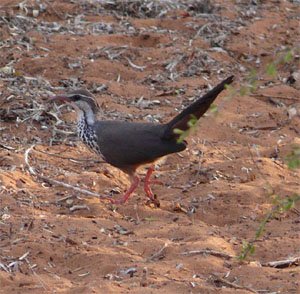
Source: Wikipedia http://www.en.wikipedia.org.
Fig. 35. Monias benschi.
There are three species of mesites placed in two genera (Gill and Donsker 2012b). These ground dwelling birds will typically run when frightened. Though they are believed to be ancient, they are not known from the fossil record (Roberson 2012). Again, this family is unique enough to occupy its own order, so it seems a natural place to consider the level of the kind.
Order Cariamiformes
Cariamidae (The Seriema kind)
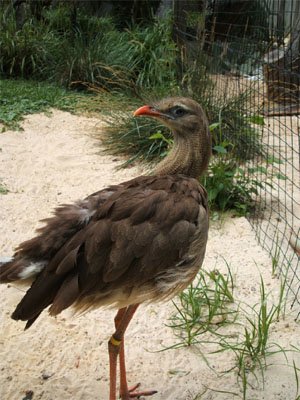
Source: Wikipedia http://www.en.wikipedia.org.
Fig. 36. Cariama cristata.
There are only two species of seriema, each in their own genus (Gill and Donsker 2012b). These birds are not well known; they run and hunt in semi-open drier regions in southern South America. There is controversy over how the seriema is related to other birds (Roberson 2012), suggesting the level of the kind is best placed here.
Order Eurypygiformes
Rhynochetidae (The Kagu kind)
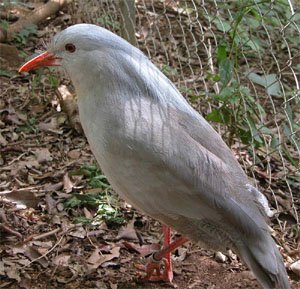
Source: Wikipedia http://www.en.wikipedia.org.
Fig. 37. Rhynochetos jubatus.
The single species in this family inhabits New Caledonia, an island in the South Pacific. It has long legs and a grayish body. The bill and feet are a remarkable reddish-orange. They are flightless and consume various invertebrates found on the forest floor (Roberson 2012). DNA hybridization studies place the kagu near the seriema (Cariamidae) within a rather large order Gruiformes (Sibley and Monroe 1990). However, there is no hybrid evidence to support combining what are different orders in the IOU taxonomic scheme.
Eurypygidae (The Sunbittern kind)
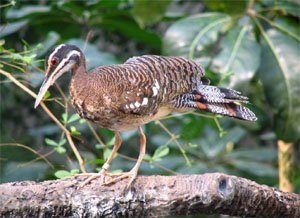
Source: Wikipedia http://www.en.wikipedia.org.
Fig. 38. Eurypyga helias.
The single species of sunbittern inhabits water-edge habitat in Central and South America. The taxonomic position of these birds is uncertain, though they have certain morphologic and behavioral similarities to the kagu. For example, there are similarities in the protein of the egg white and there are showy patterns on the wings that can be displayed (Roberson 2012). However, DNA hybridization studies place them in a separate infraorder in Gruiformes (Sibley and Monroe 1990), suggesting they may actually be a separate kind.
Order Gruiformes
Sarothruridae (The Flufftail kind)

Source: Wikipedia http://www.en.wikipedia.org.
Fig. 39. Sarothrura rufa.
The nine species of flufftails are in a single genus. They are considered a sister taxon to finfoots (Heliornithidae; Gill and Donsker 2012b). They inhabit various regions in Africa. Based on DNA hybridization, Sibley and Monroe (1990) place them in Rallidae, suggesting the level of the kind could actually be higher than indicated here. However, since there is a cognitum at the family and no hybrid data suggesting they are related beyond this, the level of kind is assigned to this default level; that is, the family.
Heliornithidae (The Finfoot kind)
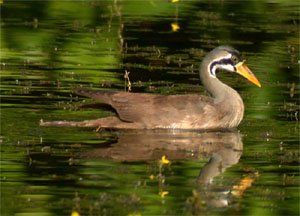
Source: Wikipedia http://www.en.wikipedia.org.
Fig. 40. Heliopais personatus.
There are three species, each placed in the own genus (Gill and Donsker 2012b). The sungrebe and finfoots are unusual aquatic birds that inhabit the tropics. They have lobed feet for swimming and eat mostly while in the water (Roberson 2012). Sibley and Monroe (1990) place finfoots in with the limpkin (Aramidae) based on data from one of the three species. However, since these birds are generally not well studied, the level of kind is left at the family for now.
Rallidae (The Rail kind)
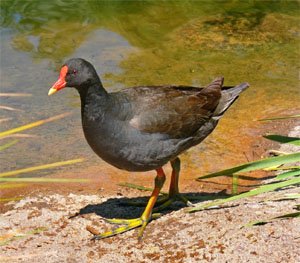
Source: Wikipedia http://www.en.wikipedia.org.
Fig. 41. Gallinula tenebrosa.
The 151 species are placed in 38 genera, though a few of these are now believed to be extinct (Gill and Donsker 2012b). This diverse group includes the rails, crakes, gallinules, and coots. Most are small to medium ground dwellers with relatively short wings and tails. They have strong feet and legs. Many are found in close association with water, with the duck-like coots being the most aquatic (Roberson 2012). Hybrid data connects two relatively large genera, Fulica and Gallinula (McCarthy 2006).
Psophiidae (The Trumpeter kind)

Source: Wikipedia http://www.en.wikipedia.org.
Fig. 42. Psophia crepitans.
The three species of trumpeters are found in a single genus (Gill and Donsker 2012b). They are elusive ground dwellers that live in small groups. They are about the size of a chicken and live in lowland forests in northern South America (Roberson 2012). Taxonomists agree they belong together, but disagree in how they are related to other birds. The various suggestions are from different orders (Handbook of the Birds of the World Alive). This difficulty in determining relationship may be because they are not actually related to any of them, so the level of the kind is placed here.
Gruidae (The Crane kind)
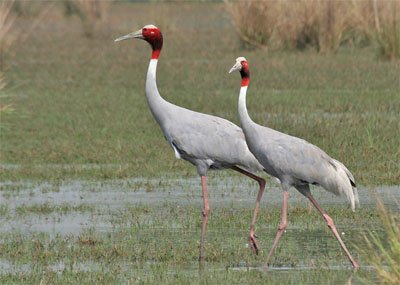
Source: Wikipedia http://www.en.wikipedia.org.
Fig. 43. Grus antigone antigone.
The 15 species of cranes are placed in two genera (Gill and Donsker 2012b). There is hybrid data connecting these two genera (McCarthy 2006). Cranes are large with blue heron-like body proportions. They generally mate for life. They are found in open regions. Many are migratory; they fly with their neck extended forward (unlike a blue heron) and feet extended behind them (Roberson 2012). It has been proposed that they are closely related to the limpkin (Aramidae), trumpters (Psophiidae), and bustards (Otididae) based on various features. In some schemes these families are all in the same order, Gruiformes (Handbook of the Birds of the World Alive). This certainly leaves open the possibility that the level of the kind is higher, but there is enough ambiguity that the level of the kind will be left at the family.
Aramidae (The Limpkin kind)

Source: Wikipedia http://www.en.wikipedia.org.
Fig. 44. Aramus guarauna.
There is a single species of limpkin (Gill and Donsker 2012b). They inhabit marshes of the New World tropics. While they superficially appear somewhat like an ibis, they are anatomically more similar to cranes and behaviorally share similarities with rails. DNA comparisons have found high similarity to the family Heliornithidae, the sungrebes and finfoots (Roberson 2012). This all suggests that the kind may actually be above the family level. However, it will be left here for this study since no hybrid data is available to support this possibility.
Order Charadriiformes
(The Shorebird kind)

Source: Wikipedia http://www.en.wikipedia.org.
Fig. 45. Vanellus miles.
Hybrid data connects the ruff (Philomachus pugnax) and the crowned lapwing (Vanellus coronatus; McCarthy 2006). They are members of the sandpiper (Scolopacidae) and plover (Charadriidae) families respectively. These two families are the largest in this order apart from the gulls (Laridae). Other smaller families fit easily within this cognitum, particularly ones bearing plover as part of their common name.
Based on DNA-DNA hybridization studies, Sibley and Monroe (1990) place Scolopacidae and Charadriidae in separate parvorders (level below infraorder and above superfamily). Combining these two groups means 18 of the 19 families that Gill and Donsker (2013) place in this order would be considered from a single created kind. This includes 368 species, some of which are now extinct.
This is not entirely unexpected. Many of the smaller families have species which exhibit traits reminiscent of several other families in this grouping. For example, the Magellanic plover inhabits the southern tip of South America and was once placed in the plover family (Charadriidae). However, it behaves more like a turnstone (Scolopacidae) and has anatomical traits like the sheathbill (Chionidae). It is now usually placed in its own monotypic family (Pluvianellidae). Similarly, the crab plover (Dromadidae) is the sole member of its family. It has a pied appearance like avocets (Recurvirostridae), and a heavy bill and feeding habits like one genus of thick-knees (Burhinidae). It digs burrows for nesting like auks (Alcidae), and its tarsal scutellation and the color pattern of down on the chicks most closely resembles gulls (Laridae; Roberson 2012). Other families in this order include Haematopodidae, Ibidorhynchidae, Rostratulidae, Jacanidae, Pedionomidae, Thinocoridae, Glareolidae, and Stercorariidae.
Statistical analysis was performed on a dataset that included only Alcidae. It appeared to divide the family, with one of the five tribes showing strong correlation within the group and weak discontinuity with some of the other tribes. This was not completely compatible with previous molecular analysis (Wood 2008). Since there is no indication of how this family relates to outgroups, the statistical analysis was not deemed helpful in determining its baraminic status. Since Sibley and Monroe (1990) place Turnicidae in a separate order based on their DNA studies, it will be considered a separate kind here.
Turnicidae (The Buttonquail kind)

Source: Wikipedia http://www.en.wikipedia.org.
Fig. 46. Turnix melanogaster.
There are 17 species in this family, all but one of which are in a single genus (Gill and Donsker 2013). These small, ground-dwelling birds appear superficially similar to quail, but they are considered unrelated. They differ from quail in that they lack a hind toe and crop. Females have an enlarged trachea and an inflatable region of the esophagus which they use to produce their booming call. Determining to which taxon they are most closely related has proved to be a conundrum. Suggestions have been made that they were allied with a number of divergent taxa (Handbook of the Birds of the World Alive). Given this ambiguity, it may well indicate they are not truly related to another taxon, but are instead a created kind.
Order Pterocliformes
Pteroclidae (The Sandgrouse kind)

Source: Wikipedia http://www.en.wikipedia.org.
Fig. 47. Pterocles bicinctus.
There are 16 species placed in two genera (Gill and Donsker 2013). Though it is readily agreed that members of this family are closely related to each other, it is hotly debated how the family is related to other birds. Linnaeus originally placed them in the same genus as the European grouse. Later it was pointed out that they had similarities to doves. Then it was suggested they were more closely related to shorebirds. DNA and other biochemical evidence reveal significant similarity between them and the waders of Charadriiformes (Roberson 2012). Given that the taxa they are postulated as being related to are so diverse, it may indicate they are actually a distinct kind.
Order Columbiformes
Columbidae (The Dove kind)

Source: Wikipedia http://www.en.wikipedia.org.
Fig. 48. Columba livia.
Gill and Donsker (2013) list 335 species in 45 genera, a few of which are now extinct. This distinctive family is distributed worldwide and easily recognized by most people. Thirteen genera are connected by hybrid data and two other genera have hybridized with each other (McCarthy 2006). Given the strong cognitum, it seems the level of the kind is here.
Order Psittaciformes
(The Parrot kind)

Source: Wikipedia http://www.en.wikipedia.org.
Fig. 49. Ara ararauna.
Three families are recognized in this order: Strigopidae (New Zealand parrots), Cacatuidae (cockatoos) and Psittacidae (parrots). The first two are small, comprising four and 21 species respectively. There are 363 species of parrots, a few of which are now extinct (Gill and Donsker 2013). There are a number of genera within Psittacidae which are linked by hybrid data. One documented cross between Galah and Eastern Rosella resulted in fertile eggs, which unites the family Psittacidae with Cacatuidae (McCarthy 2006). This provides the basis for combining the three families. Sibley and Monroe (1990) place all these species in a single family as well.
Order Opisthocomiformes
Opisthocomidae (The Hoatzin kind)

Source: Wikipedia http://www.en.wikipedia.org.
Fig. 50. Opisthocomus hoazin.
The Hoatzin is an unusual bird whose relationship to other birds has been debated. It inhabits the lowland swamps of South America. Its diet consists of leaves, fruits, and flowers. It digests its food by foregut fermentation, which is highly unusual for a bird. Its chicks have two claws on each budding wing which can be used to grip objects as they move about. Like most birds they have anisodactyl feet, with three forward pointing toes and one toe that points back (Roberson 2012). Given its distinct characteristics and unclear relationship to other birds, the family/order seems the logical place for the kind.
Order Musophagiformes
Musophagidae (The Turaco kind)

Source: Wikipedia http://www.en.wikipedia.org.
Fig. 51 Tauraco persa.
This family is comprised of 23 species in six genera (Gill and Donsker 2013). These African birds have a semi-zygodactylous toe formation. The fourth toe can be held next to the third, or moved around to point backwards. This unique flexibility allows them to move along branches and through vegetation with great agility. They also have two copper pigments that are unknown in other birds (Handbook of the Birds of the World Alive). As with so many of the single family orders, it seems the level of the kind should be here.
Order Cuculiformes
Cuculidae (The Cuckoo kind)

Source: Wikipedia http://www.en.wikipedia.org.
Fig. 52. Guira guira.
This family comprises nearly 150 species in over 30 genera (Gill and Donsker 2013). It is a diverse family that has been identified as including seven distinct subgroups. They are unusual in having zygodactyl feet, with two toes pointing forward and two pointing rearward. Most species are insectivorous. The roadrunner is probably the best known member of this family (Roberson 2012).
Order Strigiformes
Tytonidae (The Barn Owl kind)
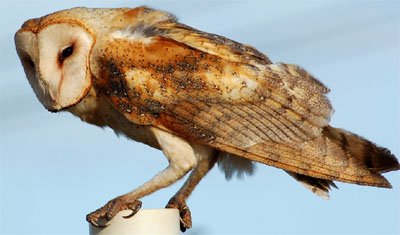
Source: Wikipedia http://www.en.wikipedia.org.
Fig. 53. Tyto alba.
This family comprises 18 species placed in two genera (Gill and Donsker 2013). These owls have a hearted-shaped facial disk and a long, compressed bill. Their eyes are proportionally smaller than those of typical owls. They have features of their feet and sternum that differ as well (Cholewiak 2003c). Fertile eggs have been reported from a cross between the two genera (McCarthy 2006).
Strigidae (The Owl kind)
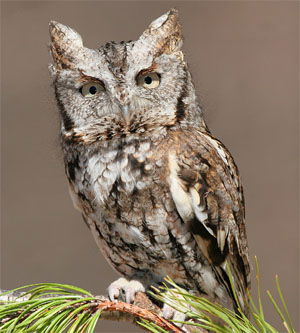
Source: Wikipedia http://www.en.wikipedia.org.
Fig. 54. Megascops asio.
Typical owls are comprised of 211 species in about 25 genera (Gill and Donsker 2013). Hybrids are considered to be rare in owls. There are two intergeneric crosses that have been observed in captivity: Athene with Speotyto and Bubo with Strix. McCarthy (2006) points out that many species of owls are hard to identify clearly, resulting in confusion regarding species and generic limits. This obviously makes the identification of hybrids more difficult when even the parents are difficult to identify. Further, due to their nocturnal behavior and sometimes inaccessible habitats, owls are relatively poorly studied. Therefore, any hybridization which is occurring is less likely to be identified compared to other, better studied groups of birds.
Order Caprimulgiformes
Members of this order are also nocturnal and not as well studied as most other birds. Many types are very similar, yet treated as separate species, creating the same problems with identifying hybrids as mentioned for owls. Most caprimulgids are not bred in captivity, and all interspecific hybrids are intrageneric (McCarthy 2006).
Podargidae (The Frogmouth kind)

Source: Wikipedia http://www.en.wikipedia.org.
Fig. 55. Podargus strigoides.
Gill and Donsker (2013) identify 16 species placed in three genera. They are characterized by a very wide, strong bill from which they derive their name. Based on various characteristics, including DNA-DNA hybridization, they appear to be related to other families in this order, particularly the nightjars (Caprimulgidae; Handbook of the Birds of the World Alive). However, the level of the kind is kept at the family due to lack of sufficient data, especially hybrid data, to placing it higher.
Steatornithidae (The Oilbird kind)
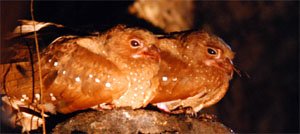
Source: Wikipedia http://www.en.wikipedia.org.
Fig. 56. Steatornis caripensis.
There is only a single species of this strange, large, fruit-eating nightbird. It breeds and roosts in caves. It uses echolocation in the caves like bats, but it also has huge eyes and excellent night vision. It can fly fast, slow, or hover. This bird is represented in the fossil record in the Green River formation (Roberson 2012). Until more information comes available, the level of the kind is placed at the family.
Nyctibiidae (The Potoo kind)
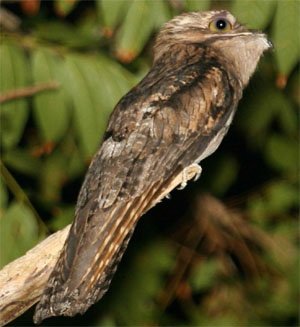
Source: Wikipedia http://www.en.wikipedia.org.
Fig. 57. Nyctibius jamaicensis.
The seven species belong to a single genus (Gill and Donsker 2013). There are various morphological and behavioral features that distinguish them from other families in this order, such as lack the bristles around the mouth and a “toothed” beak. Yet they have various features similar to several of the other families in this order. They are usually considered most closely related to nightjars (Handbook of the Birds of the World Alive). Since the various families they are postulated as being related to are in the same order, it is possible that the level of the kind is higher. However, this order is not as well studied as many others and hybrid evidence is lacking. Thus, for now, the level of the kind is placed at the family.
Caprimulgidae (The Nightjar kind)
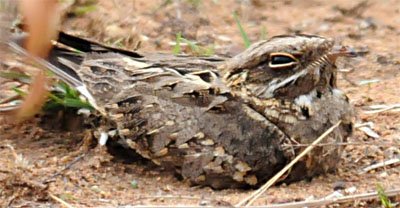
Source: Wikipedia http://www.en.wikipedia.org.
Fig. 58. Caprimulgus asiasticus.
The 95 species of this family are placed in 21 genera (Gill and Donsker 2013). They are found in a variety of habitats around the world except for the Polar Regions. Their family name is literally goat-suckers based on the belief that they suckled goats at night. In reality these nocturnal birds are mostly insectivorous. They have strange calls and a small bill which opens a cavernous mouth that collects their prey (Alderfer 2005).
Order Apodiformes
Aegothelidae (The Owlet-nightjar kind)

Source: Wikipedia http://www.en.wikipedia.org.
Fig. 59. Aegotheles cristatus.
This family is comprised of ten species in a single genus (Gill and Donsker 2013). Sibley and Monroe (1990) place this family and members of Caprimulgiformes in the same order as owls. This alternative grouping based on DNA-DNA hybridization studies also is consistent with their common name. These nocturnal birds are not well studied and no hybrid data is available for them (McCarthy 2006). Given the ambiguity and lack of hybrid data, the level of the kind is left at the family.
Hemiprocnidae (The Treeswift kind)

Source: Wikipedia http://www.en.wikipedia.org.
Fig. 60. Hemiprocne coronata.
This family is comprised of four species in a single genus (Gill and Donsker 2013). These insectivorous birds live in forests of the Malay Peninsula and islands of that region. Though considered to be closely related to swifts, they differ in several anatomic features (Roberson 2012). While the similarities may suggest the level of the kind is higher, it is left at the level of the family for now for want of hybrid data.
Apodidae (The Swift kind)

Source: Wikipedia http://www.en.wikipedia.org.
Fig. 61. Apus apus.
The 105 species in this family are divided among 19 genera (Gill and Donsker 2013). They were once thought to be closely related to swallows because of some superficial similarities, but are no longer believed to be so. They are the most aerial of all birds, and generally only perch near their nests. They have strong claws which enable them to perch on vertical surfaces. They have a small bill, but a large gape for feeding on aerial arthropods (Alderfer 2005). McCarthy (2006) only reports intrageneric hybrids.
Trochilidae (The hummingbird kind)
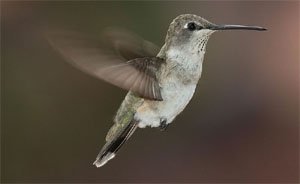
Source: Wikipedia http://www.en.wikipedia.org.
Fig. 62. Archilochus alexandri.
Gill and Donsker (2013) recognize 342 species in over 100 genera. These tiny birds beat their wings incredibly fast and, by rotating their wings, can even fly backwards. Hybrid data connects at least 26 of the genera. In addition, there are several more isolated crosses that connect two genera which are unconnected with any others (McCarthy 2006). The cognitum is also very strong for these birds, suggesting the level of the family is a good place to consider the level of the kind.
Order Coliiformes
Coliidae (The Mousebird kind)

Source: Wikipedia http://www.en.wikipedia.org.
Fig. 63. Urocolius macrourus.
There are six species of mousebirds placed in two genera (Gill and Donsker 2013). Sometimes referred to as colies, these unique arboreal birds are found in sub-Saharan Africa. In 1872 it was suggested they should be a separate order based on morphological peculiarities. Molecular studies have confirmed this (Roberson 2012).
Order Trogoniformes
Trogonidae (The Trogon kind)

Source: Wikipedia http://www.en.wikipedia.org.
Fig. 64. Pharomachrus mocinno.
This family is comprised of 43 species in seven genera (Gill and Donsker 2013). These birds have brightly colored plumage, particularly in the males. They are well represented in the forests of the Neotropics, while other species are found in Africa and Asia. One genus includes five species of quetzals. The best known is the resplendent quetzal (Pharomachrus mocinno); the male of this species has one of the longest tails known and is featured on the Guatemala flag and coat-of-arms (Roberson 2012). As a single family order, it is convenient to place the level of the kind here.
Order Leptosomiformes
Leptosomidae (The Cuckoo Roller kind)
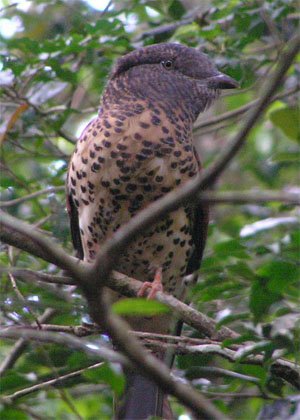
Source: Wikipedia http://www.en.wikipedia.org.
Fig. 65. Leptosomus discolor.
This single species is endemic to the island of Madagascar. Its head seems disproportionately large compared to the rest of its body. They are relatively tame. They often fly in circles and are occasionally mistaken for small hawks because of their short, broad wings. However, their flight pattern differs; they alternate quick wingbeats and glides, resulting in an undulating pattern (Roberson 2012). Although initially thought to be a cuckoo, subsequent studies have consistently found them to be more closely allied with rollers. This may suggest the level of the kind is higher, but it will be left at the family level for this single family order.
Order Coraciiformes
Coraciidae (The Roller kind)
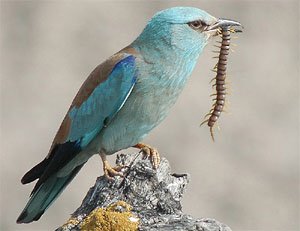
Source: Wikipedia http://www.en.wikipedia.org.
Fig. 66. Coracias garrulus.
This family is comprised of 12 species in two genera (Gill and Donsker 2013). Although these birds are relatively common in much of Africa, and parts of Asia and Australia, they remain relatively poorly studied. They are considered related to cuckoo rollers (Leptosomidae) and ground rollers (Brachypteraciidae). Yet they share features with a number of other families which are now suspected to be from convergent evolution (Handbook of the Birds of the World Alive). So while the level of the kind may be higher, it will be left here until stronger evidence suggests otherwise.
Brachypteraciidae (The Ground Roller kind)
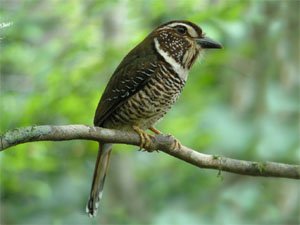
Source: Wikipedia http://www.en.wikipedia.org.
Fig. 67. Brachypteracias leptosomus.
The five species of this family are placed in four different genera (Gill and Donsker 2013). They are found only in Madagascar. Four species inhabit the rain-forest; one inhabits the spiny deserts of the southwest. The latter, the long-tailed ground-roller, has such an interesting mix of characteristics that its specific name is chimaera (Roberson 2012).
Alcedinidae (The Kingfisher kind)
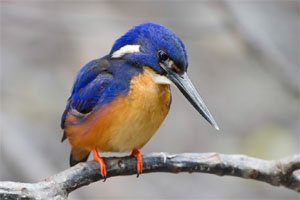
Source: Wikipedia http://www.en.wikipedia.org.
Fig. 68. Alcedo azurea ruficollaris.
This family is comprised of 95 species in 19 genera (Gill and Donsker 2013). Within this family there are three distinct subfamilies which some authors will elevate to the status of family (Roberson 2012). McCarthy (2006) only reports intrageneric hybrids, which could be argued as sufficient reason to place the kind at this lower grouping. However, the cognitum unifying them is strong and they are believed to be closely related. While the size and tail length varies considerably among them, they have large heads sporting a long, strong beak and short legs (Alderfer 2005).
Todidae (The Tody kind)
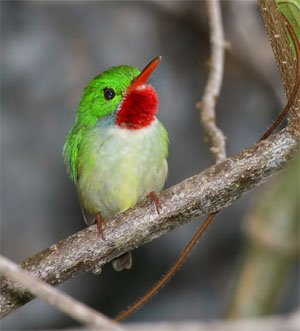
Source: Wikipedia http://www.en.wikipedia.org.
Fig. 69. Todus todus.
The five species in this family are placed in a single genus (Gill and Donsker 2013). These birds are native to the Caribbean and look like miniature kingfishers. Their green color, long, flattened beaks and ability to hover explains why the local people call them colibri, which means hummingbird. They are now usually considered most closely related to motmots of the Neotropics (Handbook of the Birds of the World Alive). While the level of the kind may be higher, there is no hybrid data connecting any families in this order.
Momotidae (The Motmot kind)

Source: Wikipedia http://www.en.wikipedia.org.
Fig. 70. Momotus momota.
This family is comprised of 14 species in 6 genera (Gill and Donsker 2013). These sit-and-wait hunters inhabit the Neotropics. They will suddenly burst out and snatch their prey, which are generally invertebrates or small vertebrates. A number of the species have a long tail with racquets at the end (Roberson 2012).
Meropidae (The Bee-eater kind)

Source: Wikipedia http://www.en.wikipedia.org.
Fig. 71. Merops apiaster.
There are 27 species in this family arranged in three genera (Gill and Donsker 2013). Bee-eaters are attractive birds found in Africa and Asia. As their name implies, bees usually comprise a major part of their diet. They vary from social species of the open country to retiring inhabitants of dense Asian jungles (Roberson 2012).
Order Bucerotiformes
Upupidae (The Hoopoe kind)

Source: Wikipedia http://www.en.wikipedia.org.
Fig. 72. Upupa epops.
This family comprises three extant species in a single genus (Gill and Donsker 2013). These Old World birds have long, thin, downward curving bills, a chunky body, broad wings, square tails, and impressive crests. They differ from other birds in the order in that they lack an expansor secondarium muscle and their young are not naked, but covered with down upon hatching. They do share a range of characters with the woodhoopoes and are placed near them based on DNA-DNA hybridization (Alderfer 2005; Handbook of the Birds of the World Alive; Roberson 2012). Yet they are distinctive and no hybrid data connects this family with another, so the level of the kind is left here.
Phoeniculidae (The Wood Hoopoe kind)

Source: Wikipedia http://www.en.wikipedia.org.
Fig. 73. Phoeniculus purpureus.
Gill and Donsker (2013) list nine species in two genera and recognize this family as a sister taxon to hoopoes (Upupidae). These birds have a long, downward curved bill and share a variety of other characteristics with the hoopoe. The most obvious difference is that they lack the crest (Handbook of the Birds of the World Alive). All this could suggest that the level of the kind is higher than the family. However, based on DNA-DNA hybridization, it was suggested this family be divided, and that wood hoopoes (genus Phoeniculus) and the scimitarbills (genus Rhinopomastus) be considered separate, though related, families. This means ignoring the obvious cognitum of this family. In fact, the black wood hoopoe (aka black scimitarbill) was initially named based on morphological similarities to other woodhoopoes (Phoeniculus), but is now classified as scimitarbill (Rhinopomastus) based on genetic similarity. Its bill doesn’t live up to the new name (Handbook of the Birds of the World Alive). For now it seems best to leave the level of the kind at the family.
Bucerotidae (The Hornbill kind)
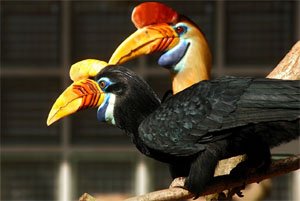
Source: Wikipedia http://www.en.wikipedia.org.
Fig. 74. Aceros cassidix.
This family comprises 59 species divided among 13 genera. They are recognized as a sister taxon to ground hornbills, both of which are considered related to the hoopoes and woodhoopoes (Gill and Donsker 2013). These impressive birds have a large, deep, downward curved bill. They inhabit a variety of habitats in the Old World tropics. When nesting, the female is sealed inside the nest cavity and fed by the male though a tiny slit while she incubates the eggs (Roberson 2012). Despite some hints the level of the kind may be higher, it is kept here as no hybrid data connects these families.
Bucorvidae (The Ground Hornbill kind)

Source: Wikipedia http://www.en.wikipedia.org.
Fig. 75. Bucorvus leadbeateri.
The two species in this family are in a single genus (Gill and Donsker 2013). At one time they were considered a subfamily of hornbills. Unlike hornbills, they do not seal the female inside the nest cavity. They also hop instead of walk, lack a carotid artery (unlike all other birds), and have 15 neck vertebrae instead of 14. They inhabit grasslands and savanna in sub-Saharan Africa (Roberson 2012).
Order Piciformes
Galbulidae (The Jaçamar kind)
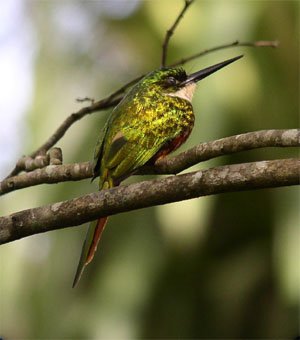
Source: Wikipedia http://www.en.wikipedia.org.
Fig. 76. Galbula ruficauda melanogenia.
Gill and Donsker (2013) report 18 species in five genera. When these birds were first identified centuries ago they were classified as kingfishers. Today convincing evidence has accumulated to establish them as a sister taxon to puffbirds (Bucconidae). Yet despite this perceived close relationship, there are number of traits which distinguish these two families (Handbook of the Birds of the World Alive). Thus, for now, the level of the kind will be designated at the family.
Bucconidae (The Puffbird kind)

Source: Wikipedia http://www.en.wikipedia.org.
Fig. 77. Malacoptila panamensis.
This family is comprised of 36 species in ten genera (Gill and Donsker 2013). These birds have a relative large head and large eyes, as well as a fairly heavy beak that is swollen at the base. Despite the fact that over half the species have been known for over 150 years, much is still unknown about these difficult-to-study birds (Handbook of the Birds of the World Alive).
Capitonidae (The New World Barbets)

Source: Wikipedia http://www.en.wikipedia.org.
Fig. 78. Eubucco bourcierii.
This family is comprised of 15 species in two genera (Gill and Donsker 2013). Barbets are tropical species which excavate holes to lay eggs and have zygodactyl feet, where two toes point forward and the other two point backward. The New World barbets are considered more closely related to the toucan-barbet and the toucan than to Old World barbets. However, the Old World barbets are ecological counterparts to the New World species (Roberson 2012). No hybrid data connects these families.
Semnornithidae (The Toucan Barbet kind)
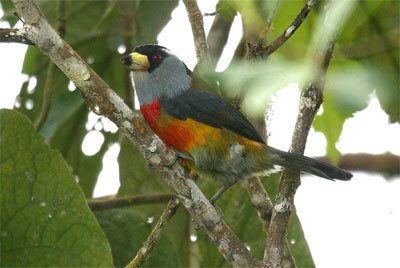
Source: Wikipedia http://www.en.wikipedia.org.
Fig. 79. Semnornis ramphastinus.
Both species in this family are in a single genus (Gill and Donsker 2013). At one time they were placed with New World barbets in the toucan family. There is some controversy over whether they are more closely related to barbets or toucans. These fruit-eating species inhabit the Andes of Colombia and Ecuador (Roberson 2012).
Ramphastidae (The Toucan kind)
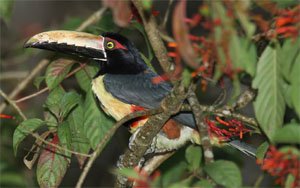
Source: Wikipedia http://www.en.wikipedia.org.
Fig. 80. Pteroglossus torquatus.
Gill and Donsker (2013) list 46 species in five genera. Toucans are distinctive-looking birds of the New World Neotropics which most people can readily recognize. Despite the distinctive appearance, considerable evidence suggests that they are simply large-billed barbets. Most species eat primarily fruit (Roberson 2012). Thus it is quite possible that the level of the kind is above the current family level, but it is kept here because hybrid data is lacking.
Megalaimidae (The Asian Barbet kind)

Source: Wikipedia http://www.en.wikipedia.org.
Fig. 81. Megalaima oorti.
This family comprises 30 species in three genera (Gill and Donsker 2013). Most are small to medium sized birds. These chunky birds are often colorful. However, it is often easier to hear them than see them. They make sounds like woodpeckers as they excavate nest holes in rotten wood. Like the woodpecker they have zygodactyl feet for clinging to the side of trees, but they lack the stiff tail. Their calls are also prominent in the forests they inhabit (Roberson 2012).
Lybiidae (The African Barbet kind)
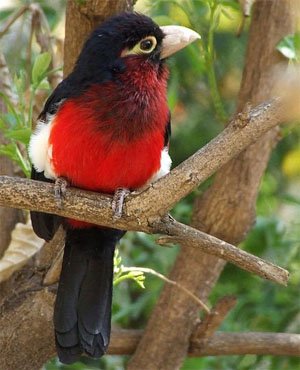
Source: Wikipedia http://www.en.wikipedia.org.
Fig. 82. Lybius bidentatus.
Gill and Donsker (2013) list 42 species in seven genera. They live in a wide range of habitats, from dense jungles to open thornscrub savanna. Like other barbets they nest in holes; in the savanna these are excavated in termite mounds. These latter birds are more insectivores, while most barbets eat primarily fruit (Roberson 2012).
Indicatoridae (The Honeyguide kind)
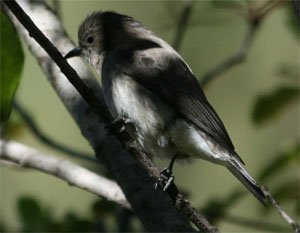
Source: Wikipedia http://www.en.wikipedia.org.
Fig. 83. Prodotiscus regulus.
This family comprises 17 species in four genera (Gill and Donsker 2013). They have dull plumage and lay their eggs in the nests of other birds, especially small barbets and tinkerbirds. These birds eat beeswax and honeycomb, and their name reflects the fact that they can be followed to a source of honey (Roberson 2012).
Picidae (The Woodpecker kind)
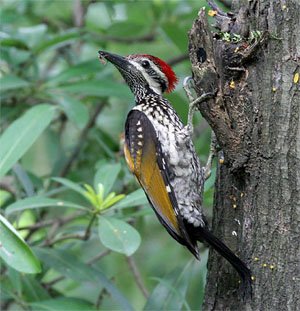
Source: Wikipedia http://www.en.wikipedia.org.
Fig. 84. Dinopium benghalense.
This family comprises 232 species in 30 genera (Gill and Donsker 2013). Two relatively large genera, Colaptes and Melanerpes, are connected by hybrid data. A second intergeneric hybrid has been reported between two other genera, but it is considered doubtful by McCarthy (2006). All woodpeckers have a similar design equipping them for a life of chiseling wood. This includes shock-absorbing head musculature, extremely long tongues, and stiff tail feathers that help them perch upright on the side of trees (Roberson 2012). Thus it seems reasonable that these many different species are part of the same created kind.
Order Passeriformes
The remaining birds are part of a huge order known as Passeriformes, often known as perching birds. This order includes over half the world’s bird species (Gill and Donsker 2013). It is incredibly diverse and includes a number of families that are united by hybridization data (Lightner 2010). As seen below, the taxonomic position of many species has been subject to considerable controversy.
Acanthisittidae (The New Zealand Wren kind)

Source: Wikipedia http://www.en.wikipedia.org.
Fig. 85. Xenicus gilviventris.
Gill and Donsker (2013) recognize two extant species each in their own genus. One species, the Rifleman, can be found on North, South, and Stewart Islands in New Zealand. Despite the loss of native habitat, they remain reasonably common. The second species is limited to the South Island. Several other species have become extinct since people have colonized the islands (Roberson 2012).
Eurylaimidae (The Broadbill kind)

Source: Wikipedia http://www.en.wikipedia.org.
Fig. 86. Eurylaimus javanicus.
Gill and Donsker (2013) list 20 species in 12 genera. This family of largely tropical Asian and African (i.e. paleotropical) birds now includes the asities (formerly Philepittidae) which inhabit Madagascar. The Sapayoa, a New World species, has been added to this family as well. These birds are considered closely related to pittas (Pittidae), but no hybrid data connects these two families (Handbook of the Birds of the World Alive).
Pittidae (The Pitta kind)

Source: Wikipedia http://www.en.wikipedia.org.
Fig. 87. Pitta cyanea.
This family is comprised of 33 species in three genera (Gill and Donsker 2013). Historically there was debate concerning to which taxa these paleotropical birds are most closely related. Currently they are believed to be most closely related to broadbills (Eurylaimidae), which is supported by multiple lines of evidence including DNA-DNA hybridization (Handbook of the Birds of the World Alive). However, there is no hybrid data connecting this family with another and the cognitum isn’t very informative as there is considerable intrafamilial diversity.
Furnariidae (The Ovenbird kind)

Source: Wikipedia http://www.en.wikipedia.org.
Fig. 88. Furnarius rufus.
This family comprises 307 species in over 70 genera. The woodcreepers, formerly placed in the family Dendrocolaptidae, had always been considered closely related and are now considered phylogenetically embedded in the family (Gill and Donsker 2013). Hybrid data connect the woodcreeper genera Dendrocolaptes and Hylexetastes (McCarthy 2006). These birds range through every habitat in South America with some species extending north as far as Mexico. The name ovenbird comes from oven-shaped mud nest constructed by several species in the genus Furnarius. Most species do not construct this type of nest. The North American oven bird is unrelated, belonging instead to the New World warblers, Parulidae (Handbook of the Birds of the World Alive; Roberson 2012).
Thamnophilidae (The Antbird kind)

Source: Wikipedia http://www.en.wikipedia.org.
Fig. 89. Gymnopithys leucaspis.
Gill and Donsker (2013) list 228 species in this family. They are confined to the Neotropics, where they predominantly occupy niches in various lowland forests. Unlike some surrounding families, these birds have distinctive features enabling one to more easily identify members of this family, though some would only be obvious to an experienced birder. Despite the many species, they are surprisingly constrained in color combinations and patterns. Most have a similar beak and prey on various invertebrates (Roberson 2012).
Formicariidae (The Antthrush kind)

Source: Wikipedia http://www.en.wikipedia.org.
Fig. 90. Chamaeza nobilis.
This family is comprised of 12 species in two genera (Gill and Donsker 2013). These neotropical birds once occupied the same family as the antbirds, but multiple lines of evidence (e.g. syringeal morphology and DNA-DNA hybridization) resulted in their removal. In some schemes the antpittas (Grallariidae) were included in this family, but they now appear more closely related to tapaculos (Rhinocryptidae) based on DNA-DNA hybridization (Handbook of the Birds of the World Alive). While it is possible the level of the kind is higher, there is no hybrid data and no strong cognitum to support it.
Grallariidae (Antpitta kind)

Source: Wikipedia http://www.en.wikipedia.org.
Fig. 91. Grallaria ruficapilla.
Gill and Donsker (2013) recognize 51 species in this family. These birds are also confined to the Neotropics. They generally live on or near the ground. Their relatively drab coloration provides camouflage. They communicate extensively through vocalizations, but are often hard to spot (Roberson 2012).
Conopophagidae (The Gnateater kind)

Source: Wikipedia http://www.en.wikipedia.org.
Fig. 92. Conopophaga castaneiceps.
Comprised of 11 species in two genera, these birds are restricted to Central and South America (Gill and Donsker 2013). Their family placement has been controversial. They appear somewhat like small antpittas. Most are sexually dimorphic. The males make a buzzing sound as they fly around their territory at dawn or dusk (Roberson 2012). The level of the kind is left at the family because there is no clear cognitum or hybrid data indicating that it is higher.
Rhinocryptidae (The Tapaculo kind)

Source: Wikipedia http://www.en.wikipedia.org.
Fig. 93. Acropternis orthonyx.
Gill and Donsker (2013) recognize 56 species. Roberson (2012) calls them “the mice of the avian world” because of the way they scuttle through undergrowth. These birds of the New World tropics were once postulated to be related to the scrub birds or lyrebirds of Australia, but they are more similar genetically to gnateaters and antbirds. Again, this hints that the level of the kind may be higher, but supporting hybrid data is absent and no higher cognitum is obvious.
Melanopareiidae (The Crescentchest kind)

Source: Wikipedia http://www.en.wikipedia.org.
Fig. 94. Melanopareia torquata.
All four species are in a single genus (Gill and Donsker 2013). The colorful birds inhabit the dryer regions of central South America. At one time they had been placed in with the tapaculos. However, they have a relatively long tail and two of them have a white intrascapular patch like many antbirds (Roberson 2012).
Tyrannidae (The Tyrant Flycatcher kind)
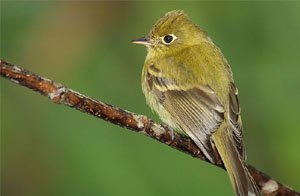
Source: Wikipedia http://www.en.wikipedia.org.
Fig. 95. Empidonax flavescens.
Gill and Donsker (2013) list 421 species. Hybrid data connect the genus Contopus with Empidonax and Empidonomus with Tyrannus (McCarthy 2006). They inhabit many habitats in North and South America. As their name implies, many eat insects and other arthropods. Some sit patiently until a suitable meal comes nearby. While there are other flycatchers in the Old World, they do not appear to be related to this New World family (Roberson 2012).
Cotingidae (The Cotinga kind)
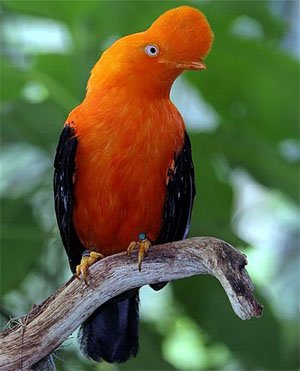
Source: Wikipedia http://www.en.wikipedia.org.
Fig. 96. Rupicola peruviana.
Gill and Donsker (2013) identify 64 species in this family. One other species, the swallow-tailed cotinga, is listed separately (as part of incertae sedis 1, since it is unclear to which family it should be assigned), but it will be included here for this analysis. Tyrant flycatchers, cotingas, manakins, and tityras are all considered to be closely related, and are placed by Sibley and Monroe (1990) in a single family. This suggests the level of the kind is actually higher than recognized here, but no hybrid data is available to support this.
Pipridae (The Manakin)
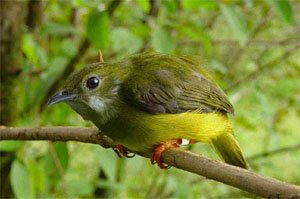
Source: Wikipedia http://www.en.wikipedia.org.
Fig. 97. Manacus candei.
This family is comprised of 52 species in 14 genera (Gill and Donsker 2013). These are tiny birds of the New World tropics (Roberson 2012). Intergeneric hybrids have been reported, forming two groups of three genera each (McCarthy 2006). Wood (2008) analyzed a dataset which appeared to separate out some members of the genus Pipra from the rest of the family. Since all 58 characters related to aspects of syringeal morphology, Wood concluded that wholly syringeal datasets are not informative baraminologically.
Tityridae (The Tityra kind)
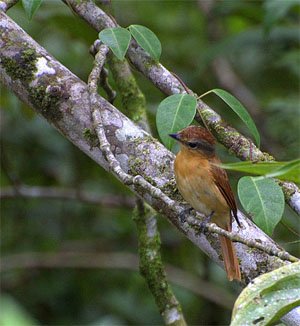
Source: Wikipedia http://www.en.wikipedia.org.
Fig. 98. Pachyramphus castaneus.
This family is comprised of 45 species (Gill and Donsker 2013). Historically it was difficult to find boundaries between the tyrant flycatchers, cotingas, and manakins. Classification was based on the shape of the bill, the scutellation of the tarsus, and whether or not the toes were united, and to what degree. Later molecular evidence was used to create a fourth family, Tityridae. In many of the genera, similarity to members of the other families is attributed to convergent evolution. While this classification scheme resolves numerous difficulties, some still remain (Roberson 2012). Due to the difficulty in finding a clear cognitum in this family and the three preceding it, and the fact that members of these families appear genetically very similar, the level of the kind is probably not really at the family level. For now Philabura and Calyptura, placed in incertae sedis 1 by Gill and Donsker (2003), are absorbed in the above for this assessment. However, more research is necessary to address this uncertainty.
Menuridae (The Lyrebird kind)
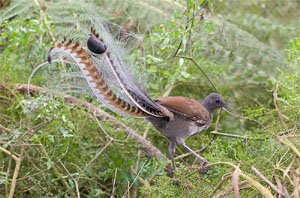
Source: Wikipedia http://www.en.wikipedia.org.
Fig. 99. Menura novaehollandiae.
The two species of lyrebirds are in a single genus (Gill and Donsker 2013). These Australian birds are named for the stunning tail of the male Superb Lyrebird which resembles a Greek lyre. The 16 tail feathers consist of two lyrates, two medians, and 12 filaments. Though normally carried behind the bird, he will fan them forward over his head during a courtship display. Males of the other species lack the two lyrate feathers (Roberson 2012).
Atrichornithidae (The Scrub-bird kind)

Source: Wikipedia http://www.en.wikipedia.org.
Fig. 100. Atrichornis clamosus.
Scrub-birds also consist of two species in a single genus (Gill and Donsker 2013). These birds are also found in Australia. They live in isolated areas and one species was thought to be extinct until it was rediscovered in 1961. They live in deep leaf litter where they consume invertebrate prey. They are difficult to see, but can often be identified by their singing (Roberson 2012).
Ptilonorhynchidae (The Bowerbird kind)

Source: Wikipedia http://www.en.wikipedia.org.
Fig. 101. Ptilonorhynchus violaceus.
Gill and Donsker (2013) identify 20 species in eight genera. Hybrid data connects the genus Ptilonorhynchus with Sericulus (Handbook of the Birds of the World Alive). Bowerbirds are found in Australia and New Guinea. Some are colorful, while other species are drab. Most males build bowers to attract a female. These impressive structures may take months to build and are sometimes decorated with colorful objects (Roberson 2012).
Climacteridae (The Australian Treecreeper kind)

Source: Wikipedia http://www.en.wikipedia.org.
Fig. 102. Climacteris picumnus.
This family is comprised of seven species placed in two genera (Gill and Donsker 2013). One species lives in the mountains of New Guinea while the rest inhabit Australia. As their name implies, they slowly travel up the trunks of trees as they search for insects to feed on. Unlike members of other families that exhibit similar behavior, they do not use their tail to prop themselves up. They are syndactylous with the second and third digit bound together by a membrane that extends to the end of the first toe bone (proximal phalanx) of digit two. Digits three and four are bound together to the base of the third toe bone. This anatomical arrangement appears to help them creep up the tree trunks (Roberson 2012).
Maluridae (The Australasian Wren kind)
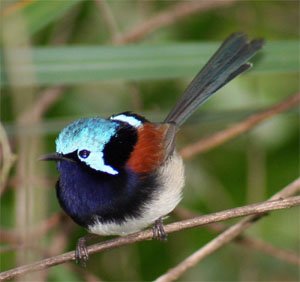
Source: Wikipedia http://www.en.wikipedia.org.
Fig. 103. Malurus elegans.
Gill and Donsker (2013) recognize 29 species in six genera. Four of these are commonly known as fairy-wrens. The other species comprise emu-wrens and grasswrens. Most of these Australasian little birds are active and territorial. They carry their tail in a cocked position and do not migrate. Many also have striking plumage patterns (Roberson 2012).
Meliphagidae (The Honeyeater kind)
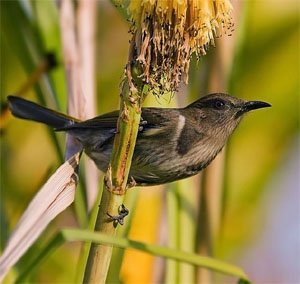
Source: Wikipedia http://www.en.wikipedia.org.
Fig. 104. Phylidonyris pyrrhopterus.
This family is comprised of 184 species (Gill and Donsker 2013). They are essentially restricted to Australasia, but are widespread throughout this region. They are the dominant bird in both Australia and New Guinea. Members of this family have a brush-tipped tongue that collects fluids by capillary action. Most honeyeaters feed on nectar by rapidly extending and retracting their tongue. They also are important pollinators of endemic plants in Australia (Roberson 2012). One intergeneric cross has been reported (McCarthy 2006).
Dasyornithidae (The Bristlebird kind)
This family is comprised of three species in a single genus (Gill and Donsker 2013). They are native to Australia. Not all authors place these birds in their own family (Roberson 2012). Sibley and Monroe (1990) place them and the Australasian warblers in Pardalotidae. Bristlebirds have similarities with scrub-birds (Atrichornithidae) that are believed to be from convergent evolution. Birds from both families excel at moving secretively in dense, low vegetation. They are similar in size and appearance, but have distinct vocalizations (Roberson 2012). The controversy over placement may indicate the level of the kind is higher, since it is among families in the same order. However, there is no hybrid data or obvious cognitum to substantiate this.
Pardalotidae (The Pardalote kind)

Source: Wikipedia http://www.en.wikipedia.org.
Fig. 105. Pardolatus striatus ornatus.
This family of Australasian birds has four species in a single genus (Gill and Donsker 2013). Though taxonomically unrelated, these birds are somewhat like nuthatches in size, shape, and behavior. However, in addition to foraging on tree trunks and cones, they can be found among the leaves of trees as well. They are often found on Eucalyptus trees where they consume the sweet exudate of psyllids, small plant-sucking insects (Roberson 2012).
Acanthizidae (The Australasian Warbler kind)

Source: Wikipedia http://www.en.wikipedia.org.
Fig. 106. Acanthiza pusilla.
Gill and Donsker (2013) place 65 species in this family, though one species is now extinct. The family includes thornbills, scrubwrens, gerygones, white-faces, and some unusual ground-dwelling species. Some species of thornbills are quite similar and difficult to differentiate (Roberson 2012).
Family incertae sedis 2 (The Mohoua kind)
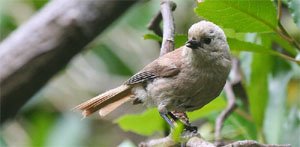
Source: Wikipedia http://www.en.wikipedia.org.
Fig. 107. Mohoua albicilla.
Gill and Donsker (2013) place the genera Mohoua and Finschia separately as their taxonomic position is uncertain. Three species are recognized: the yellowhead, whitehead, and pipipi. Sibley and Monroe (1990) place them in the crow family (Corvidae) based on DNA-DNA hybridization. Given the uncertainty, they will be considered a separate kind here (Roberson 2012). For other species that do not fit neatly into a family, such as those designated incertae sedis 1 and incertae sedis 3 by Gill and Donsker, they are sometimes included in a nearby family for this work if it seems there is sufficient evidence to do so.
Pomatostomidae (The Australasian Babbler kind)
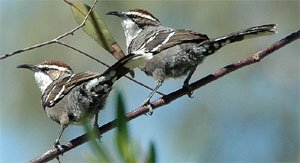
Source: Wikipedia http://www.en.wikipedia.org.
Fig. 108. Pomatostomus ruficeps.
Gill and Donsker (2013) recognize five species in two genera. At one time these birds and logrunners (Orthonychidae) were grouped with other Old World babblers (Roberson 2012). Their removal was largely the result of the work by Sibley and Monroe (1990). Based on the DNA-DNA hybridization work, evolutionists now recognize a great Australasian radiation. The major families in this group were divided between the menurids (Menuridae, Atrichornithidae, Meliphagidae, et al.) and corvids (Corvidae, Paradisaeidae, Cracticidae, et al.). Both Pomatostomidae and Orthonychidae are placed with corvids (Roberson 2012). It remains to be seen if this Australasian radiation seems plausible within the creation model, which does not assume universal common ancestry. So far significant intergeneric hybrid data has not been documented.
Orthonychidae (The Logrunner kind)

Source: Wikipedia http://www.en.wikipedia.org.
Fig. 109. Orthonyx temminckii.
Gill and Donsker (2013) recognize three species in a single genus. These ground-dwelling birds sometimes forage for berries. More commonly they scratch through the leaf litter on the forest floor for small invertebrates, leaving a characteristic small circular cleared area. Though they were at one time considered related to quail-thrushes and their allies, they are now considered part of a corvid radiation that arose in Australasia (Roberson 2012). The level of the kind is left at the family due to insufficient evidence to place it elsewhere.
Cnemophilidae (The Satinbird kind)

Source: Wikipedia http://www.en.wikipedia.org.
Fig. 110. Cnemophilus macgregorii.
This family is comprised of three species in two genera (Gill and Donsker 2013). They are a poorly studied group of birds native to the uplands of New Guinea. Initially it was thought they were related to bowerbirds (Ptilonorhynchidae) until Ernst Mayr found anatomical evidence suggesting they were more closely related to birds of paradise (Paradisaeidae). Cnemophilidae were removed from the latter family based on DNA evidence suggesting that they and bowerbirds were instead part of the corvid assemblage that arose in Australasia (Roberson 2012). Due to the ambiguity, the level of the kind is left at the family.
Melanocharitidae (The Berrypecker/Longbill kind)
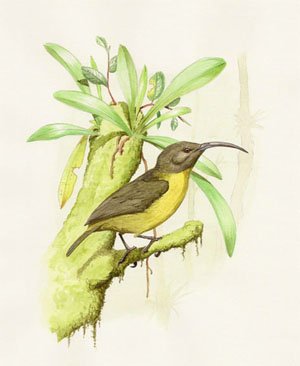
Source: Wikipedia http://www.en.wikipedia.org.
Fig. 111. Toxorhamphus poliopterus.
This family comprises ten species in four genera (Gill and Donsker 2013). This family was only recently identified based on DNA-DNA hybridization. Prior to that members of this family had been classified with flowerpeckers (Dicaeidae), honeyeaters (Meliphagidae), or sunbirds (Nectariniidae). Unsurprisingly, the family is morphologically diverse (Handbook of the Birds of the World Alive). The level of the kind is placed here by default.
Paramythiidae (The Painted Berrypecker kind)

Source: Wikipedia http://www.en.wikipedia.org.
Fig. 112. Paramythia montium montium.
This family is comprised of two species in separate genera (Gill and Donsker 2013). These brightly colored, berry-eating birds inhabit the New Guinea highlands. At one time they were placed with flowerpeckers (Dicaeidae), but they and the typical berrypeckers were removed from that family based on DNA-DNA hybridization evidence. This evidence also supported placing berrypeckers beside painted berrypeckers, but more recent sequencing of nuclear genes may challenge that view (Roberson 2012). For now the level of the kind is left at the family.
Callaeidae (The New Zealand Wattlebird kind)
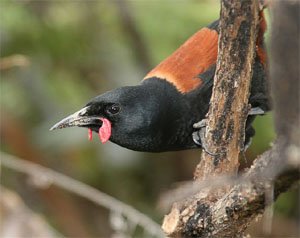
Source: Wikipedia http://www.en.wikipedia.org.
Fig. 113. Philesturnus carunculatus.
Gill and Donsker (2013) list five species in three genera. Two of these species (comprising one genus) are recently extinct. Their extinction is blamed on the introduction of non-native species, particularly brown and black rats. New Zealand wattlebirds are so named because of the fleshy wattles. These are orange in all species except for the North Island Kokako, in which they are blue (Roberson 2012).
Notiomystidae (The Stitchbird kind)
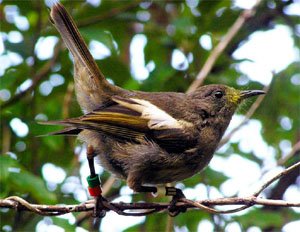
Source: Wikipedia http://www.en.wikipedia.org.
Fig. 114. Notiomystis cincta.
This family is comprised of a single species (Gill and Donsker 2013). The stitchbird was once considered one of three species of honeyeaters endemic to New Zealand. DNA evidence supports the fact that the other two species are honeyeaters, but the stitchbird was found to be more similar to the New Zealand wattlebirds (Callaedae). This forest species inhabits the North Island and surrounding islets (Roberson 2012). Since there is not an obvious cognitum including the stitchbird and the wattlebirds, the level of the kind is kept at the family.
Psophodidae (The Whipbird kind)

Source: Wikipedia http://www.en.wikipedia.org.
Fig. 115. Psophodes occidentalis.
Gill and Donsker (2013) recognize 16 species in four genera. In this family they include not only whipbirds, but wedgebills, jewel-babblers, and quail-thrush. In the past these species and logrunners were all in the family Orthonychidae. It was the DNA-DNA hybridization evidence that resulted in the removal of the logrunners. In some taxonomic schemes, quail-thrush are also removed to a separate family based on subsequent DNA evidence (Roberson 2012). Sometimes this type of controversy involving closely related families may be from the level of the kind being higher than the family. For now, it is kept at the default level to avoid underestimating the total number of avian kinds.
Platysteiridae (The Batis kind)
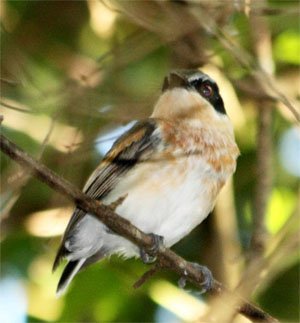
Source: Wikipedia http://www.en.wikipedia.org.
Fig. 116. Batis fratrum.
This family comprises 33 species in five genera (Gill and Donsker 2013). They are medium-sized African birds, over half of which are in the genus Batis. There has been controversy of which species belong in this family, or if this group should even be recognized as a family. Some authors have placed them in with the brush-shrikes (Malaconotidae). Sometimes helmet-shrikes and vangas have been lumped in with them as well. However, more recent biochemical work has resulted in these groups being considered as separate families (Roberson 2012). Again, this type of controversy may suggest the level of the kind is higher. Since no hybrid data supports this, it is left at the family level for now.
Tephrodornithidae (The Woodshrike kind)
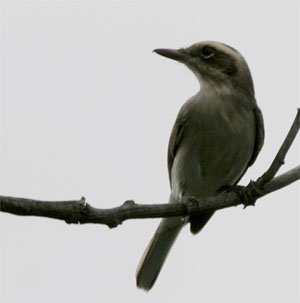
Source: Wikipedia http://www.en.wikipedia.org.
Fig. 117. Tephrodornis pondicerianus.
This family is comprised of eight species in three genera (Gill and Donsker 2013). They are small forest birds of tropical Asia. They had traditionally been placed in with cuckoo-shrikes (Campephagidae). Some authors place them in with vangas (Vangidae; Roberson 2012). Based on recent research, Gill and Donsker (2012b) place Woodshrikes in their own family with flycatcher-shrikes and Philentoma.
Prionopidae (The Helmetshrike kind)
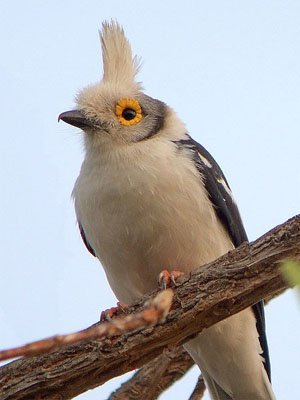
Source: Wikipedia http://www.en.wikipedia.org.
Fig. 118. Prionops plumatus.
This family comprises eight species in a single genus (Gill and Donsker 2013). Some authors place these birds in with vangas (Vangidae). Based on DNA evidence it is now believed that three clades exist among these types of birds. The first is the core bush-shrikes (Malaconotidae). The second is the batises and wattle-eyes (Platysteiridae). The third includes shrike-flycatchers (Tephrodornithidae), helmet-shrikes, and vangas (Roberson 2012). In keeping with Gill and Donsker (2013) the latter three are separated out at the family level here. However, given the longstanding uncertainty, it seems reasonable to postulate that the level of the kind may include all these taxa. However, as with a number of previous taxa, the level of the kind is kept at the family level since hybrid data fails to connect these taxa, it is unclear where the kind would be placed if it is higher, and we want to avoid underestimating the number of kinds on the Ark for this project.
Malaconotidae (The Brushshrike kind)
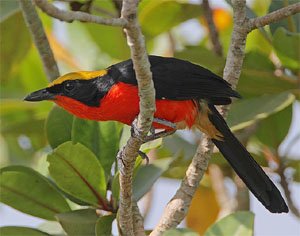
Source: Wikipedia http://www.en.wikipedia.org.
Fig. 119. Laniarius barbarus.
Gill and Donsker (2013) recognize 50 species in this family. They inhabit sub-Saharan Africa and are considered closely related to helmet-shrikes (Prionopidae), vangas (Vangidae), batises and wattle-eyes (Platysteiridae). Most species are loud with distinctive calls, but they are often difficult to see (Roberson 2012).
Machaerirhynchidae (The Boatbill kind)

Source: Wikipedia http://www.en.wikipedia.org.
Fig. 120. Macaerirhynchus flaviventer.
This family is comprised of two species in single genus (Gill and Donsker 2013). These Australasian birds had previously been placed in the same family as monarch flycatchers (Monarchidae). They have many behaviors that are similar to flycatchers; however, a few behaviors are quite distinctive. Recent biochemical evidence suggests that they are not closely related, and thus they are now placed in a separate family (Roberson 2012).
Vangidae (The Vanga kind)
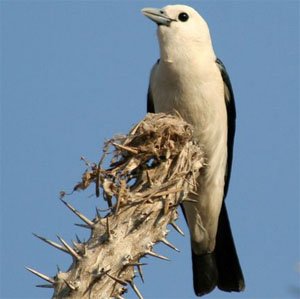
Source: Wikipedia http://www.en.wikipedia.org.
Fig. 121. Artamella viridis.
This family comprises 21 species in 15 genera (Gill and Donsker 2013). This diverse group of woodland birds occupies many niches on the island of Madagascar. From the dry, open, spiny forest to the humid jungle, members of this family generally prey on invertebrates or small vertebrates. Diversification within this family is believed to have arisen rapidly (within the last 10 million years on the evolutionary scale) and rivals that of the Hawaiian honeycreepers and Galapagos finches (Roberson 2012).
Cracticidae (The Butcherbird kind)
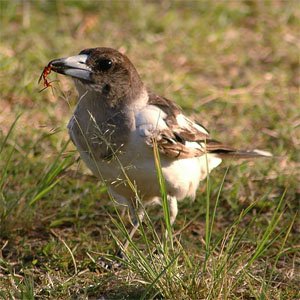
Source: Wikipedia http://www.en.wikipedia.org.
Fig. 122. Cracticus nigrogularis.
This family comprises 12 species in four genera (Gill and Donsker 2013). There is a reported hybrid between the Australian magpie (Gymnorhina tibicen) and the pied butcherbird (Cracticus nigrogularis), connecting two of these genera (McCarthy 2006). Birds of this family typically have large bills and strong legs. They inhabit Australasia and New Guinea and are often found on or near the ground in open areas (Roberson 2012).
Pityriaseidae (The Bristlehead kind)

Source: Wikipedia http://www.en.wikipedia.org.
Fig. 123. Pityriasis gymnocephala.
This single species has recently been promoted to its own family. It is an unusual bird that lives in the canopy of lowland forests of Borneo. In the past it had been placed with the wood-shrikes or jays and crows. Biochemical evidence has placed it near woodswallows (Artamidae) and butcherbirds (Cracticidae). This rare and elusive bird is not well studied (Roberson 2012).
Artamidae (The Woodswallow kind)

Source: Wikipedia http://www.en.wikipedia.org.
Fig. 124. Artamus cyanopterus.
Gill and Donsker (2013) recognize 11 species in a single genus. Based on their DNA-DNA hybridization work, Sibley and Monroe (1990) place members of Cracticidae, Pityriaseidae, and this family (Artamidae) together in the same tribe as a subfamily beside crows in a greatly expanded Corvidae family. In addition to the genetic similarity, there are morphologic similarities. For example, woodswallows share many distinctive features of skull morphology with two genera in Cracticidae (Handbook of the Birds of the World Alive). Thus it is possible the kind may include all three families, but it is placed here until more substantial information becomes available.
Aegithinidae (The Ioras kind)
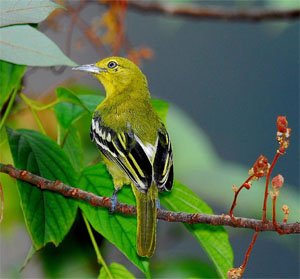
Source: Wikipedia http://www.en.wikipedia.org.
Fig. 125. Aegithina tiphia.
This family comprises four species in a single genus (Gill and Donsker 2013). They are found throughout tropical Asia. They generally forage alone for berries, other fruit, or insects. Though traditionally placed near the babblers (Timaliidae), biochemical studies suggest they are more similar to Muscicapidae. The taxonomic relationship of these families remains controversial (Roberson 2012).
Campephagidae (The Cuckooshrike kind)
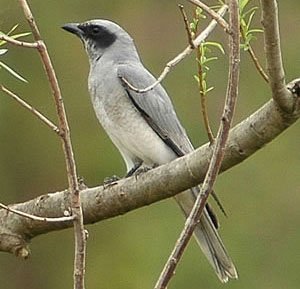
Source: Wikipedia http://www.en.wikipedia.org.
Fig. 126. Coracina novaehollandiae.
This family comprises 92 species in six genera (Gill and Donsker 2013). Traditionally, over half the species were placed in a single genus, Coracina. Based on genetic evidence this genus is believed to actually consist of at least five different groups. These birds are primarily arboreal and found in the Old World, primarily the tropics of Australasia and southeastern Asia (Roberson 2012).
Neosittidae (The Sittella kind)
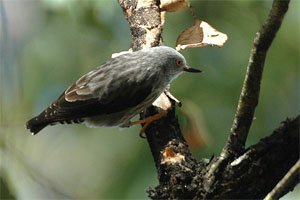
Source: Wikipedia http://www.en.wikipedia.org.
Fig. 127. Daphoenositta chrysoptera.
This family is comprised of three species in a single genus (Gill and Donsker 2013). The members of this small Australasian family appear something like nuthatches, but it has long been known they aren’t related to them (Roberson 2012). They are considered closely related to whistlers (Pachycephalidae). Sibley and Monroe (1990) place these two families in separate tribes within a single subfamily. While not in the same subfamily as crows and jay, they are part of the greatly expanded Corvidae presented by these authors. Again, this suggests the level of the kind may be higher, but it is not clear where similarity based on DNA-DNA hybridization is truly from common ancestry or may be from common design.
Pachycephalidae (The Whistler kind)
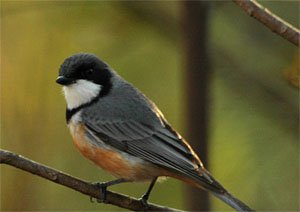
Source: Wikipedia http://www.en.wikipedia.org.
Fig. 128. Pachycephala rufiventris.
Gill and Donsker (2013) recognize 58 species in eight genera. For this analysis the wattled ploughbill, which Gill and Donsker separate as incertae sedis 3, will also be included here. Pachycephalidae is an Australasian family which includes whistlers, shrike-thrushes, and the shrike-tit. The shrike-tit’s status in this family has been questioned, and it was briefly in a separate family with the wattled ploughbill, but has since been returned to this family based on further nuclear DNA evidence (Roberson 2012). Sibley and Monroe (1990) treat the shrike-tit part of a separate tribe within the same subfamily as the rest of these species. The two remaining tribes in that subfamily include the sittellas (Neosittidae) and the genera Mohoua/Finschia (incertae sedis 2). Given that DNA-DNA hybridization evidence was used to place these families together in a single subfamily, the level of the kind might easily be higher than the currently recognized family.
One interesting genus placed in this family by Gill and Donsker (2013) is Pitohui. These birds are known to be toxic. The toxin is acquired by eating poisonous melyrid beetles and is stored in the skin and feathers. It is a powerful neurotoxin similar to that found in poison dart frogs. The people of New Guinea have long known of their toxic effects and avoid eating them. In studying this one genus, some researchers suggested its members really belong to four different families! Roberson (2012) discusses them under Oriolidae where he recognizes the two most toxic pitohuis belong. Again, this evidence seems to suggest that the level of the kind is above the family. Yet the DNA based similarity is not necessarily from common ancestry.
Laniidae (The Shrike kind)
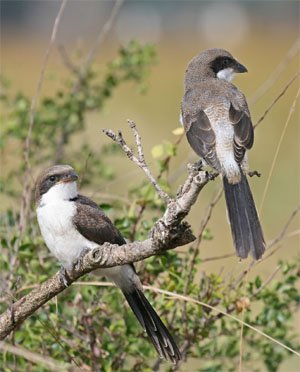
Source: Wikipedia http://www.en.wikipedia.org.
Fig. 129. Lanius cabanisi.
This family comprises 33 species in four genera (Gill and Donsker 2013). All but four species are in a single genus. They are medium-sized, predatory songbirds that have a hooked bill reminiscent of raptors. Though most of their diet consists of invertebrates, they occasionally prey on small vertebrates as well. At one time they were considered close relatives to bush-shrikes (Malaconotidae), helmet-shrikes (Prionopidae), vangas (Vangidae) and batises (Platysteiridae). More recently evidence supports the close relationship of the aforementioned four families, but Laniidae was placed closer to crows (Roberson 2012).
Vireonidae (The Vireo kind)
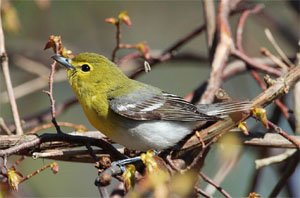
Source: Wikipedia http://www.en.wikipedia.org.
Fig. 130. Vireo flavifrons.
This family comprises 63 species in six genera. This was a strictly New World family with the largest genus containing the vireos. The three other genera include greenlets, peppershrikes, and shrike-vireos. Recent research has added two Old World genera to this family: the shrike-babblers (Pteruthius) and Erpornis (Gill and Donsker 2013).
Oriolidae (The Old World Oriole kind)

Source: Wikipedia http://www.en.wikipedia.org.
Fig. 131. Oriolus chinensis.
Gill and Donsker (2013) identify 34 species in three genera, but one genus with two species is now extinct. The smaller of the two extant genera contains figbirds. This family is comprised of medium-sized, highly arboreal birds which inhabit warmer regions of the Old World. They are not to be confused with New World species of orioles, which belong to the genus Icterus in the blackbird family, Icteridae (Roberson 2012). Sibley and Monroe (1990) place Old World orioles and cuckooshrikes (Campephagidae) together in one tribe under the same subfamily as that including crows. This placement is due to significant DNA similarity and suggests that the level of the kind could be higher. However, there is no way to know for sure that the similarity is due to common ancestry.
Dicruridae (The Drongo kind)

Source: Wikipedia http://www.en.wikipedia.org.
Fig. 132. Dicrurus bracteatus.
Gill and Donsker (2013) list 26 species in two genera. One genus is monotypic and that species, Chaetorhynchus papuensis, is thought to possibly be a whistler (Pachycephalidae). Roberson (2012) instead considers it to be a member of Rhipiduridae. Drongos are mostly black and somewhat crow-like in appearance. They eat insects much like flycatchers and many have forked tails. Some have tails that are curled on the end, while others have racquets (Roberson 2012).
Rhipiduridae (The Fantail kind)
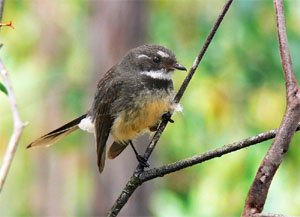
Source: Wikipedia http://www.en.wikipedia.org.
Fig. 133. Rhipidura albiscapa.
This family is comprised of 49 species in two genera. One genus is monotypic and was previously placed in the Monarchidae (Gill and Donsker 2013). Fantails are distinctive Old World flycatchers that range from India to Australia and some Pacific Islands. Most swish their splayed open tails up and down as they flit through the forest, making it obvious where they got their common name (Roberson 2012). Sibley and Monroe (1990) place them in the same subfamily as drongos and monarchs, suggesting they may be related. There is no hybrid data to corroborate this, so the families are listed as separate kinds here.
Monarchidae (The Monarch kind)
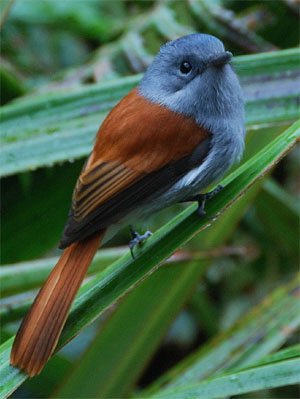
Source: Wikipedia http://www.en.wikipedia.org.
Fig. 134. Terpsiphone bourbonnensis.
This family comprises 98 species in 16 genera (Gill and Donsker 2013). This is a predominantly Old World family of birds which behave as flycatchers, darting out from their perches after flying insects. They are not believed to be related to either Old World flycatchers (Muscicapidae) or New World flycatchers (Tyrannidae). Some species have colorful bare patches encircling their eyes. Many species are colorful and the paradise-flycatchers are known for magnificent long tails in the adult male (Roberson 2012).
Corvidae (The Crow kind)

Source: Wikipedia http://www.en.wikipedia.org.
Fig. 135. Cyanocitta cristata.
This family is comprised of 130 species (Gill and Donsker 2013). Several of the numerous genera are linked by hybrid data. Crows and ravens are linked to one of the magpie genera (Corvus and Pica). There are also a number of genera of jays linked by hybrid data (Aphelocoma, Calocitta, Cyanocitta, Cyanocorax, and Psilorhinus; McCarthy 2006). Birds in this family are known for their intelligence and are the largest “songbirds” extant today (Roberson 2012).
Corcoracidae (The Australian Mudnester kind)

Source: Wikipedia http://www.en.wikipedia.org.
Fig. 136. Struthidea cinerea.
This family comprises two species each in its own genus (Gill and Donsker 2013). The apostlebird and the white-winged chough were at one time placed in a family with other birds that build mud nests, but are now considered unrelated to them (Roberson 2012). Sibley and Monroe (1990) place these two birds in their own subfamily within an expanded Corvidae family.
Family incertae sedis 4 (The Melampitta kind)
There are three species in two genera that are placed here because their taxonomic status is uncertain. The blue-capped ifrit is now considered possibly related to Monarchs (Gill and Donsker 2013). The two species of melampitta superficially resemble pittas, but the syringeal anatomy is significantly different. Morphological and genetic data haven’t always suggested the same placement of these birds that are confined to New Guinea. It is quite probable these two genera are not actually closely related to each other, though they have bounced around in families containing other Australo-Papuan songbirds (Handbook of the Birds of the World Alive). So the level of the kind could be above or below this, but it is placed here so these species are at least considered in this analysis.
Paradisaeidae (The Bird-of-paradise kind)
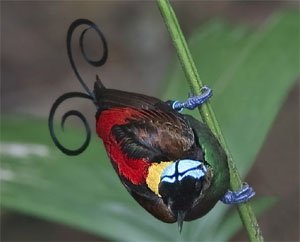
Source: Wikipedia http://www.en.wikipedia.org.
Fig. 137. Cicinnurus respublica.
This family comprises 41 species in 16 genera (Gill and Donsker 2013). It has long been known that extensive natural hybridization occurs in this family; at least nine of the currently recognized genera are connected by hybrid data (McCarthy 2006). Sibley and Monroe (1990) classify them as a tribe within the subfamily containing crows and jays. Their noisy cries are certainly reminiscent of crows, but males in this family sport an amazing variety of colorful plumes, shields, streamers, wires, and plumage (Roberson 2012).
Petroicidae (The Australasian Robin kind)
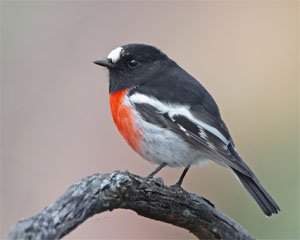
Source: Wikipedia http://www.en.wikipedia.org.
Fig. 138. Petroica boodang.
This family comprises 46 species in 14 genera (Gill and Donsker 2013). They are not related to robins from other regions of the world. They are small birds characterized by a big head, thick neck, fat body, and short tail. They fill a niche in Australasia similar to the niche filled by New World flycatchers and Old World flycatchers (Roberson 2012).
Picathartidae (The Rockfowl kind)
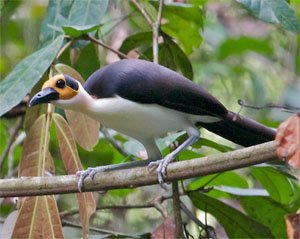
Source: Wikipedia http://www.en.wikipedia.org.
Fig. 139. Picathartes gymnocephalus.
This family is comprised of two species in a single genus (Gill and Donsker 2013). These unusual large African birds roost and nest in caves. They have bare, brightly colored heads. They forage on the forest floor. Though at one time they were lumped in with the babblers, evidence suggests they are actually more similar to rockjumpers and rail-babblers (Roberson 2012). Since it is unclear if this similarity is indicative of common ancestry, the level of the kind is left at the family level.
Chaetopidae (The Rockjumper kind)

Source: Wikipedia http://www.en.wikipedia.org.
Fig. 140. Chaetops frenatus.
This family is also comprised of two species in a single genus (Gill and Donsker 2013). This family is restricted to two African countries: South Africa and Lesotho. They live in rocky regions, as their name suggests. They run, maneuvering on their rocky habitat with great agility. They are sexually dimorphic with colorful males (Roberson 2012).
Eupetidae (The Rail-babbler kind)

Source: Wikipedia http://www.en.wikipedia.org.
Fig. 141. Eupetes macrocerus.
This family now comprises a single species (Gill and Donsker 2013). It is also a ground-dwelling species and inhabits lowland forests in Thailand, peninsular Malaysia, and the islands of Sumatra and Borneo. At one time this elusive bird was placed in with the babblers, hence its name. More often it was placed with other secretive forest dwelling birds of Australasia, such as logrunners (Orthonychidae), quail-thrush, whipbirds, and jewel-babblers (Psophodidae). Some morphologic similarities had been noted between rail-babblers and the two previous African families; more recent DNA evidence showed similarity as well, hence they are now considered sister taxa (Roberson 2012). This may suggest this species is related to other extant birds, but there is enough ambiguity that the level of the kind is placed at the default level, the family, for now.
Bombycillidae (The Waxwing kind)

Source: Wikipedia http://www.en.wikipedia.org.
Fig. 142. Bombycilla cedrorum.
This family is comprised of three species in a single genus (Gill and Donsker 2013). They are named for the waxy spots on their wings. They also sport a distinctive soft crest. The taxonomic relationships of this family are controversial (Roberson 2012). Sibley and Monroe (1990) place the palmchat and silky-flycatchers in the same family, which is placed in the same superfamily as Old World flycatchers, starlings, and mockingbirds.
Ptilogonatidae (The Silky-flycatcher kind)

Source: Wikipedia http://www.en.wikipedia.org.
Fig. 143. Phainopepla nitens.
This family comprises four species in three genera (Gill and Donsker 2013). These long-tailed, thrush-sized birds range from the southwestern United States through the forests in the western mountains of Panama. As their name implies, they eat insects and have a silky appearance to their plumage. Three of the four species have crests (Roberson 2012).
Hypocoliidae (The Hypocolius kind)

Source: Wikipedia http://www.en.wikipedia.org.
Fig. 144. Hypocolius ampelinus.
This family is comprised of a single species (Gill and Donsker 2013). This elusive bird winters in Saudi Arabia. It breeds in Iraq, Iran, and eastern Pakistan. Due to the difficulty in studying it, its relationships have long been uncertain. It had traditionally been considered related to the waxwings and silky-flycatchers, and recent research appears to confirm this (Roberson 2012). For now the level of the kind is left at the family until more information becomes available.
Dulidae (The Palmchat kind)

Source: Wikipedia http://www.en.wikipedia.org.
Fig. 145. Dulus dominicus.
This family is also comprised of a single species (Gill and Donsker 2013). The palmchat lives in Hispaniola, the island comprised of Haiti and the Dominican Republic. It is an odd bird which is very common on the island. These gregarious, vocal birds are fond of Royal palms. They build large communal nests (Roberson 2012).
Mohoidae (The Oo kind)
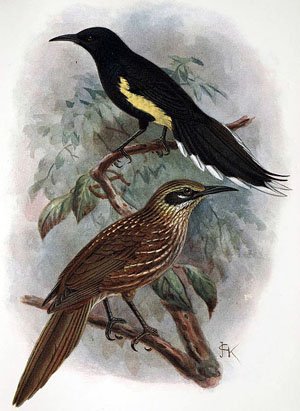
Source: Wikipedia http://www.en.wikipedia.org.
Fig. 146. Moho apicalis.
This family was comprised of five species in two genera, but all are now considered extinct. They inhabited the Hawaiian Islands and were once considered related to honeyeaters (Meliphagidae). More recent work suggests instead that they are more similar to waxwings (Bombycillidae) thus explaining their placement closer to the latter family (Gill and Donsker 2013). While most extinct birds are not considered here, this recently extinct family is included because it was listed on the IOU list.
Hylocitreidae (The Hylocitrea kind)

Source: Wikipedia http://www.en.wikipedia.org.
Fig. 147. Hylocitrea bonensis.
This family is comprised of a single species (Gill and Donsker 2013). This bird inhabits the moss forests at higher elevations in Sulawesi, an island in Indonesia. It is often referred to as the olive-flanked whistler, but recent molecular analysis indicates that it is not really a whistler. Instead, it is believed to be related to waxwings, and it has been suggested that it should have the rank of subfamily within an expanded Bombycillidae (Roberson 2012). The level of the kind is left here until further information is found substantiating this relationship.
Stenostiridae (The Fairy Flycatcher kind)

Source: Wikipedia http://www.en.wikipedia.org.
Fig. 148. Culicicapa ceylonensis.
This family comprises nine species in four genera (Gill and Donsker 2013). They inhabit tropical areas in Africa and Asia. Many behave as fantails, spreading their tail feathers while twitching their tails up and down. These were once placed in Monarchidae as were the fantails which have now been moved to Rhipiduridae. Other members of this family were once considered related to the Old World flycatchers (Muscicapidae). This family is identified based on molecular data; there is no morphological character that clearly defines this family (Roberson 2012). This, of course, means that this family lacks a clear cognitum. The level of the kind is here by default.
Paridae (The Tit kind)

Source: Wikipedia http://www.en.wikipedia.org.
Fig. 149. Lophophanes cristatus.
This family comprises 59 species in eight genera. It includes tits, titmice, and chickadees (Gill and Donsker 2013). This homogeneous family of small, lively birds is easy to identify; at one time most were placed in a single genus: Parus. They are agile birds found in forests around the world. Though Sibley and Monroe (1990) enlarged this family to include Remizidae, most taxonomies place the family level here (Roberson 2012). Since these relatively familiar birds can be identified to family fairly easily, the level of the kind is left here until a stronger case can be made to place it elsewhere.
Remizidae (The Penduline Tit kind)
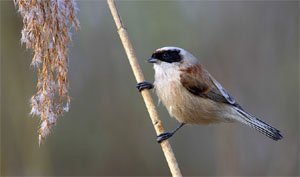
Source: Wikipedia http://www.en.wikipedia.org.
Fig. 150. Remiz pendulinus.
This family comprises 12 species in four genera (Gill and Donsker 2013). These tiny birds inhabit open and scrubby woodlands around the world, particularly in Eurasia and Africa. They are considered to be related to both tits (Paridae) and fairy flycatchers (Stenostiridae). Given their common names, close association with the tits is unsurprising, but due to biochemical distinctiveness they are kept as a separate family (Roberson 2012).
Panuridae (The Bearded Reedling kind)
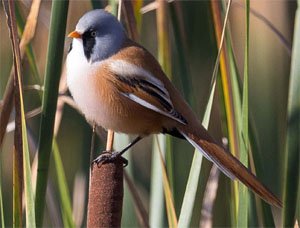
Source: Wikipedia http://www.en.wikipedia.org.
Fig. 151. Panurus biarmicus.
This family is currently comprised of a single species (Gill and Donsker 2013). This species inhabits reedy marshes of the Old World. Outside the breeding season they are gregarious and can form large flocks as the nesting season ends. Previously they were placed in a family with parrotbills (Roberson 2012).
Nicatoridae (The Nicator kind)
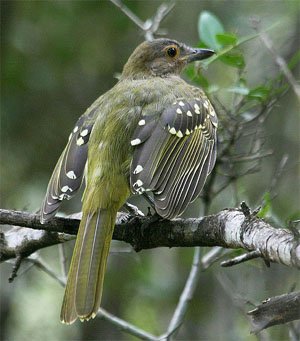
Source: Wikipedia http://www.en.wikipedia.org.
Fig. 152. Nicator gularis.
This African family is comprised of three species in a single genus (Gill and Donsker 2013). At various times historically they have been thought to be related to shrikes (Laniidae), bush-shrikes (Malaconotidae), or bulbuls (Pycnonotidae). Due to these uncertainties, they were classified as incertae sedis until they were recently given a full family status (Roberson 2012).
Alaudidae (The Lark kind)

Source: Wikipedia http://www.en.wikipedia.org.
Fig. 153. Alauda arvensis.
This family is comprised of 98 species in just over 20 genera (Gill and Donsker 2013). Larks are ground-dwelling birds which are found primarily in the Old World, especially Africa. Most have drab plumage, but many have incredible songs. Over one-third of larks are in the genus Mirafra. Roberson (2012) reports they are related to bulbuls in the Sylvioidea superfamily which also contains swallows, babblers, and many Old World warblers. Sibley and Monroe (1990) place them in the superfamily Passeroidea.
Pycnonotidae (The Bulbul kind)
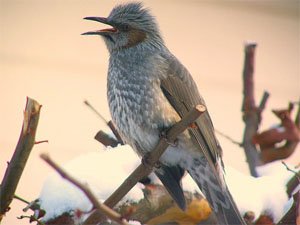
Source: Wikipedia http://www.en.wikipedia.org.
Fig. 154. Hypsipetes amaurotis.
This family comprises 151 species (Gill and Donsker 2013). They are medium-sized songbirds that are classified near swallows, babblers, and many Old World warblers. They are morphologically and ecologically homogeneous, yet they are comprised of two lineages: the Asian clade and the African clade. Most of the African clade are green or olive in color, and are sometimes referred to as greenbuls. Birds in the Asian clade are often gray and white, or brown and white. Some of the Asian species have expanded westward and now inhabit parts of Africa (Roberson 2012).
Hirundinidae (The Swallow kind)

Source: Wikipedia http://www.en.wikipedia.org.
Fig. 155. Hirundo abyssinica.
This family is comprised of 88 species (Gill and Donsker 2013). Four of the numerous genera are connected by hybrid data (Delichon, Hirundo, Riparia, Tachycineta; McCarthy 2006). They are distinctive birds with streamlined bodies. They consume insects. They often nest close to people, even sometimes within their homes (Roberson 2012).
Pnoepygidae (The Cupwing kind)
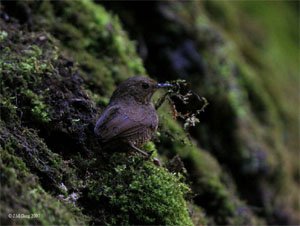
Source: Wikipedia http://www.en.wikipedia.org.
Fig. 156. Pnoepyga albiventer.
This family is comprised of four species in a single genus (Gill and Donsker 2013). They had been previously referred to as wren babblers, but DNA analysis suggests that they are unrelated to either of the babbler families (Timaliidae and Sylviidae). These tiny birds of tropical Asia have a short tail, slender bill, and reduced front claws. They are semiterrestrial and move by hopping in the tangled undergrowth. They have distinctive warbler-like songs (Roberson 2012).
Macrosphenidae (The African Warbler kind)

Source: Wikipedia http://www.en.wikipedia.org.
Fig. 157. Sphenoeacus afer.
This family comprises 18 species in six genera. Once placed in the Old World warblers (Sylviidae), this is one of many groups which have now been removed and given their own family status based on recent research. The eclectic composition of this family was not predicted based on traditional classification. It includes the grass warbler (Melocichla), the grassbird (Sphenoeacus), the rockrunner (Achaetops), five species of longbills (Macrosphenus), nine species of Crombec (Sylvietta), and Victorin’s warbler (Cryptillas). One species previously considered a longbill is actually a bulbul (Roberson 2012 ; Gill and Donsker 2013).
Cettidae (The Cettia Bush Warbler kind)

Source: Wikipedia http://www.en.wikipedia.org.
Fig. 158. Cettia fortipes.
This family is comprised of 32 species in seven genera (Gill and Donsker 2013). It is another eclectic family of birds that had previously been placed in Sylviidae. It includes diverse warblers from Eurasia and some tailorbirds from the Orient. While about half the species are known as bush-warblers, there are other bush-warblers in the family Locustellidae. Though now occupying two separate families, the bush-warblers of tropical Asia were thought to have been related based on their dull plumage and reclusive behavior. Now those similarities are attributed to convergent evolution (Roberson 2012).
Scotocercidae (The Streaked Scrub Warbler kind)
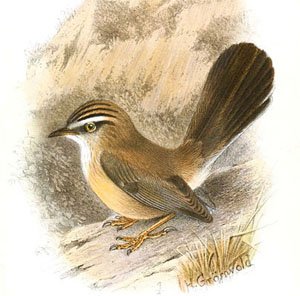
Source: Wikipedia http://www.en.wikipedia.org.
Fig. 159. Scotocerca inquieta.
This family is comprised of a single species. It was incertae sedis, of uncertain affinity, but now is considered a sister group to Cettidae. Thus it was elevated to the rank of family. The various subspecies are found in Europe, northern Africa, and parts of Asia (Gill and Donsker 2013).
Erythrocercidae (The Yellow Flycatcher kind)
This family comprises three species in a single genus (Gill and Donsker 2013). These African flycatchers dwell in the lowland forests. Traditionally they were placed with the monarch flycatchers, though some authors noted a few morphological and behavioral peculiarities. Genetic evidence suggests they are unrelated to any of the other flycatchers, but instead group with Cettia and related warblers. In some taxonomic schemes, the yellow flycatchers and streaked scrub warbler are placed in the family Cettidae (Roberson 2012).
Family incertae sedis 5 (The Hylia kind)
Gill and Donsker (2013) place three species, each in their own genus, in this fifth group of uncertain affinities. Two species are commonly known as hylias, while the third is known as Grauer’s warbler. They have been placed in a number of different families over the years, and the recent evidence suggests they are related to Aegithalidae. More research is needed to clarify where they will finally land taxonomically (Roberson 2012).
Aegithalidae (The Bushtit kind)

Source: Wikipedia http://www.en.wikipedia.org.
Fig. 160. Aegithalos caudatus.
This family is comprised of 13 species in four genera (Gill and Donsker 2013). Referred to as long-tailed tits by Roberson (2012), most of these species are found Eurasia, particularly in the Himalayas or mountains of China. There is also one North American species and one in the mountains of Java. These tiny birds are very vocal and move through trees and bushes in small family groups.
Phylloscopidae (Leaf Warbler kind)
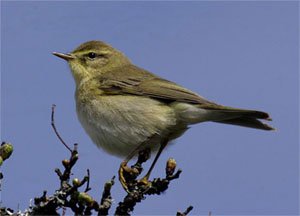
Source: Wikipedia http://www.en.wikipedia.org.
Fig. 161. Phylloscopus trochilus.
This family comprises 77 species in two genera (Gill and Donsker 2013). This is another of around a dozen families that have been extracted from the previously huge Sylviidae. For the most part they are small arboreal warblers which forage on insects on the leaves in the canopy or sub-canopy. Many are known to migrate great distances. They are often difficult for birders to identify to species (Roberson 2012).
Acrocephalidae (The Reed Warbler kind)

Source: Wikipedia http://www.en.wikipedia.org.
Fig. 162. Acrocephalus arundinaceus.
This family is comprised of five genera with 61 species, some of which are now extinct (Gill and Donsker 2013). This family is another that has originated from the fracturing of Sylviidae. Most reed warblers breed in large Old World marshes. Many are secretive and difficult to see unless they are singing. They can be very difficult to identify to species (Roberson 2012).
Locustellidae (The Grassbird kind)

Source: Wikipedia http://www.en.wikipedia.org.
Fig. 163. Megalurus palustris.
This family is comprised of 57 species in nine genera (Gill and Donsker 2013). They are often difficult to see as they skulk through grass or thickets. Based on recent studies, there has been some shifting of species between the various genera. This family is viewed as a sister group to the Malagasy warblers. These two families are considered a sister group to reed warblers, hence their placement here (Roberson 2012). There is no hybrid data indicating that these families are indeed related, so the level of the kind is left at the family for now.
Donacobiidae (The Black-capped Donacobius kind)

Source: Wikipedia http://www.en.wikipedia.org.
Fig. 164. Donacobius atricapilla.
This family is comprised of a single species (Gill and Donsker 2013). This unusual bird inhabits marshes and grassy regions of Panama and South America. They are conspicuous with a blackish back and a buff colored underside. Breeding pairs display and sing duets in their territories by the water’s edge. Once called the black-capped mockingbird, they were considered members of Mimidae. Later, they were declared to be a wren. More recent DNA-based research suggests they are neither, and are more closely related to various Old World species (Roberson 2012).
Bernieridae (The Malagasy Warbler kind)

Source: Wikipedia http://www.en.wikipedia.org.
Fig. 165. Bernieria madagascariensis.
This family comprises 11 species in eight genera (Gill and Donsker 2013). Endemic to Madagascar, these birds had previously been placed in a variety of different families. Several were previously placed in Sylviidae, a couple had been considered babblers, and still others bulbuls. Recent molecular evidence indicates that their conventional placement is incorrect and that, instead, they form a distinct group (Roberson 2012).
Cisticolidae (The Cisticola kind)

Source: Wikipedia http://www.en.wikipedia.org.
Fig. 166. Cisticola exilis.
This family is comprised of 160 species in nearly 30 genera. Most species are limited to Africa, but some are found in Asia, Europe or Australia. Many African species closely resemble each other and are often best distinguished by their song. These birds were removed from Sylviidae over two decades ago based on DNA-DNA hybridization studies. However there is still much to learn about them and their relationship to other birds (Gill and Donsker 2013; Roberson 2012).
Timaliidae (The Babbler kind)

Source: Wikipedia http://www.en.wikipedia.org.
Fig. 167. Stachyris leucotis.
This family comprises 56 species in ten genera (Gill and Donsker 2013). Babblers were part of the very large Sylviidae, but by the mid-2000s studies suggested they should be split. There has been some controversy over how many families they comprise (Roberson 2012). Here they comprise five families: tree and scimitar babblers (Timaliidae), fulvettas and ground babblers (Pellorneidae), laughing thrushes (Leiothrichidae), sylvid babblers and parrotbills (Sylviidae), and white-eyes (Zosteropidae) in conformity with Gill and Donsker (2013). Roberson (2012) places the first three as separate subfamilies within Timaliidae and retains the last two as distinct families based on recommendations by Moyle et al. (2012).
Pellorneidae (The Fulvetta/Ground Babbler kind)

Source: Wikipedia http://www.en.wikipedia.org.
Fig. 168. Pellorneum capistratum.
Gill and Donsker (2013) provisionally recognize this family to be comprised of 71 species. Most are found in China and Southeast Asia, though two genera are restricted to Africa. Several species are known as wren babblers. While previously grouped together, wren babblers in Pnoepygidae were found to be unrelated and were placed in a separate family (Roberson 2012).
Leiothrichidae (The Laughingthrush kind)

Source: Wikipedia http://www.en.wikipedia.org.
Fig. 169. Garrulax lineatus.
Gill and Donsker (2013) provisionally recognize this family, identifying 133 species in just over a dozen genera. Hybridization has occurred between two of these genera (McCarthy 2006). These birds are recognized as a major clade of babblers. They are found in Europe, Africa and Asia (Gill and Donsker 2013). They are a diverse family ranging from cheerfully colored birds to drab colored ones and they occupy a number of niches (Roberson 2012).
Sylviidae (The Sylviid Babbler kind)

Source: Wikipedia http://www.en.wikipedia.org.
Fig. 170. Sylvia atricapilla.
This family is now comprised of 70 species (Gill and Donsker 2013). At one time it included around 400 species which were known as Old World warblers. Following research using molecular data, it became evident they were not a single unified group. Thus the family was fractured into about a dozen families. The core genus in this family, Sylvia, is found mostly in Europe, northern Africa, and the Middle East. Currently members of this family are believed to be more closely related to babblers (Timaliidae). Thus the name Sylviid babblers is used to describe the group, or sometimes just the term sylvids (Roberson 2012). There is no hybrid data linking this family with others.
Zosteropidae (The White-eye kind)
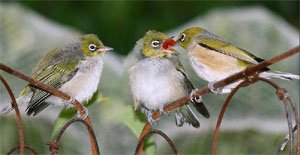
Source: Wikipedia http://www.en.wikipedia.org.
Fig. 171. Zosterops lateralis.
This family comprises 128 species (Gill and Donsker 2013). The name white-eye refers to a white ring around the eye of traditional members of this family. With the advent of molecular data this family has experienced its share of upheaval. It was discovered they were similar to babblers, so they were grouped by some with the Sylviid babblers. Others proposed they be placed in the babbler family Timaliidae. As that family broke up into several others, the white-eyes became a family again. However, the composition is not the same as before; some other species are now included. The majority of white-eyes are in a single genus Zosterops. They are found throughout the Old World, with a large proportion being specialists on various islands (Roberson 2012).
Again, this shifting among families suggests that the level of the kind may be higher, but it is unclear where it should be. The only hybrid data involving this family links it with Fringillidae via an alleged cross between a domestic canary (Serinus domesticus) and a green white-eye (Zosterops virens). McCarthy (2006) documents this report but considers it doubtful since these species are taxonomically far apart within Passeriformes. So it needs confirmation before it would be accepted as evidence that two different large superfamilies should be considered from a single created kind.
Arcanatoridae (The Dapple-throat kind)
This family is comprised of three species each in its own genus. They are found in the east African nations of Tanzania, Mozambique, and Malawi. Evolutionists now believe that Arcanatoridae and Promeropidae are basal branches, each of which go further back in time than almost any other extant lineage in the Passerida. They are treated as separate families with the expectation that evidence will establish a sister relationship (Gill and Donsker 2013). Generally speaking, extant species that are considered basal are ones that evolutionists have had trouble classifying; they are birds that do not fit well into the “tree.”
Promeropidae (The Sugarbird kind)

Source: Wikipedia http://www.en.wikipedia.org.
Fig. 172. Promerops cafer.
This family is comprised of two species in a single genus (Gill and Donsker 2013). They have been known to hybridize with each other in a particular region of South Africa. Unfortunately, there is no intergeneric hybrid data to link these to another family. This genus has been variously placed in Meliphagidae, Sturnidae, and Nectariniidae in the past (McCarthy 2006).
Irenidae (The Fairy-bluebird kind)

Source: Wikipedia http://www.en.wikipedia.org.
Fig. 173. Irena puella.
This family comprises two species in a single genus (Gill and Donsker 2013). They are tree-dwelling birds of tropical Asia. They are relatively large fruit-eating birds that live in lowland rainforests. Their relationship with other birds has been controversial. Some recent evidence suggests a close relationship with leafbirds (Chloropseidae; Roberson 2012). For now the level of the kind is kept at the family.
Regulidae (The Goldcrest/Kinglet kind)
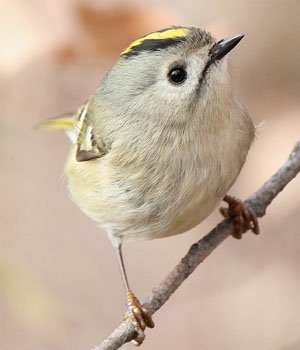
Source: Wikipedia http://www.en.wikipedia.org.
Fig. 174. Regulus regulus japonensis.
This family comprises six species in a single genus (Gill and Donsker 2013). These tiny arboreal birds inhabit the Northern Hemisphere in both the Old and New World. They are easy to recognize. They consume insects in coniferous forests and are known for the colorful markings on their crown. Their taxonomic position has been much less easy to discern (Roberson 2012). Thus the level of the kind is left at the family.
Hyliotidae (The Hyliota kind)
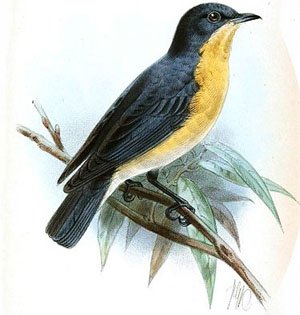
Source: Wikipedia http://www.en.wikipedia.org.
Fig. 175. Hyliota nehrkorni.
This family comprises four species in a single genus (Gill and Donsker 2013). As with so many of these smaller families, they have been variously placed in other families. This genus has previously been placed in Muscicapidae, Monarchidae, Platysteiridae, or Sylviidae, prior to the breakup of that family. They are mostly found in western and central Africa. They consume insects, sometimes in flycatcher style, but often times they meticulously search through the canopy for their prey, even sometimes hanging upside-down as they search under leaves or branches (Roberson 2012).
Troglodytidae (The Wren kind)

Source: Wikipedia http://www.en.wikipedia.org.
Fig. 176. Cistothorus palustris.
This family is comprised of 83 species in 19 genera (Gill and Donsker 2013). Two of these genera are connected by hybrid data (McCarthy 2006). Nearly all species are endemic to the New World. A fair number are adapted to desert habitats, while others skulk in undergrowth thickets in humid lowland rainforests of the Neotropics. They are often difficult to locate unless they are singing, and many are known for their distinctive vocalizations (Roberson 2012).
Polioptilidae (The Gnatcatcher kind)

Source: Wikipedia http://www.en.wikipedia.org.
Fig. 177. Polioptila californica.
This family comprises 17 species in 3 genera (Gill and Donsker 2013). There is a strong cognitum at the family level of these New World birds. Fourteen species are called gnatcatchers and are placed in the genus Polioptila. The three remaining species are known as gnatwrens. Gnatcatchers are gray and white, have long tails and thin bills, and sometimes black caps. As with many other small families, there has been considerable controversy over where to place these species taxonomically. They have been placed in various families over the years, but now occupy their own and are considered closely related to wrens (Roberson 2012). So despite the clear cognitum, the level of the kind could be higher. Still, no hybrids have been documented that support this possibility.
Sittidae (The Nuthatch kind)

Source: Wikipedia http://www.en.wikipedia.org.
Fig. 178. Sitta europaea.
This family is comprised of 28 species in a single genus (Gill and Donsker 2013). These small birds with short tails and thin bills are easy to identify to family. They are known to travel headfirst down tree trucks in search of insects or grubs. They also eat seeds. They inhabit northern continents throughout the world. They are cavity nesters, generally finding holes in trees (Roberson 2012).
Tichodromidae (The Wallcreeper kind)
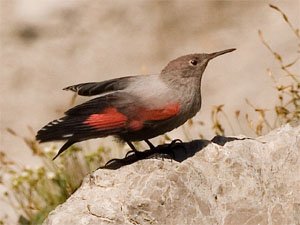
Source: Wikipedia http://www.en.wikipedia.org.
Fig. 179. Tichodroma muraria.
This family is comprised of a single species. It is distributed from southern Europe to central China (Gill and Donsker 2013). It has anatomic and behavioral similarities to the nuthatch, though it climbs rocks in search of insects rather than trees (Roberson 2012). Sibley and Monroe (1990) place it as a subfamily in the nuthatch family. So it is tempting to place the level of the kind higher, but no hybrid data supports this.
Certhiidae (The Treecreeper kind)

Source: Wikipedia http://www.en.wikipedia.org.
Fig. 180. Certhia americana.
This family is comprised of 11 species in two genera (Gill and Donsker 2013). They had historically been associated with the nuthatches, and these two families in turn to the tits and long-tailed tits. DNA-DNA hybridizations studies suggest a closer association with gnatcatchers and gnatwrens (Handbook of the Birds of the World Alive). It is difficult to interpret this situation. On one hand, the level of the kind could be high enough that it includes all these families and perhaps others. On the other hand, the ambiguity may suggest they are not related to other families. So the level of the kind is left at the family for now.
Mimidae (The Mockingbird kind)

Source: Wikipedia http://www.en.wikipedia.org.
Fig. 181. Dumetella carolinensis.
This family comprises 34 species in ten genera (Gill and Donsker 2013). It includes thrashers, mockingbirds, and catbirds. The two largest genera, Mimus and Toxostoma, which include most of the mockingbirds and thrashers respectively, are connected by hybrid data (McCarthy 2006). These New World birds are well known for their ability to mimic other birds and sounds (Roberson 2012).
Sturnidae (The Starling kind)

Source: Wikipedia http://www.en.wikipedia.org.
Fig. 182. Lamprotornis hildebrandti.
Gill and Donsker (2013) list 123 species, some of which are now extinct. These are birds of the Old World, though the common starling has been introduced worldwide. McCarthy (2006) identifies six genera (Acridotheres, Cosmopsarus, Lamprotornis, Onychognathus, Spreo, and Sturnus) that are united by hybrid data. However, a major shifting of genera took place based on works published in 2008, so two of these genera (Cosmopsarus and Spreo) have been assimilated in the others. Unsurprisingly, the four remaining are the largest of the 33 genera listed by Gill and Donsker (2013).
Buphagidae (The Oxpecker kind)

Source: Wikipedia http://www.en.wikipedia.org.
Fig. 183. Buphagus erythrorhynchus.
This family comprises two species in a single genus (Gill and Donsker 2013). They live in sub-Saharan Africa on large mammals, especially ungulates. They feed on flies, ticks, and fleas. This benefits the host, making it a predominantly mutual commensal relationship. However, they also consume tissues from wounds, blood and other secretions, and are thus considered semi-parasitic. Some authors consider them a subgroup of starlings (Sturnidae). They have significant morphologic and biochemical similarities with starlings (Roberson 2012). Further study should be done to see if the level of the kind should be elevated about the family level.
Turdidae (The Thrush kind)

Source: Wikipedia http://www.en.wikipedia.org.
Fig. 184. Turdus migratorius.
This family is comprised of 185 species (Gill and Donsker 2013). These small to medium-sized songbirds have a distinctive protrusion from the syrinx known as the “turdine thumb.” Many are impressive singers. The family has decreased in size significantly since many of the original 365 were moved to Muscicapidae. It is recognized that some further changes are likely. The largest genus, Turdus, includes birds native to all continents except Australia and Antarctica. The familiar American robin belongs to this genus (Roberson 2012).
Muscicapidae (The Chat/Old World Flycatcher kind)

Source: Wikipedia http://www.en.wikipedia.org.
Fig. 185. Melaenornis fischeri.
This family comprises 298 species (Gill and Donsker 2013). They are relatively small birds that inhabit the Old World, with a couple of exceptions that can be found in Alaska. As with many other birds, they have hopped nests in the taxonomic nested hierarchies. Once considered part of a huge group that included thrushes, Old World warblers, babblers and others, they were later divided out in a somewhat smaller group. Based on DNA-DNA hybridization, they were placed together beside thrushes in this large family. There is still some controversy over the precise limits of the group (Roberson 2012).
Cinclidae (The Dipper kind)
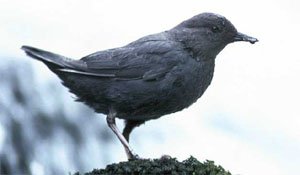
Source: Wikipedia http://www.en.wikipedia.org.
Fig. 186. Cinclus mexicanus.
This family comprises five species in a single genus (Gill and Donsker 2013). These birds are found worldwide near fresh water pools, waterfalls, rivers, and streams. They dive into the water after a variety of underwater prey, including small fish and aquatic invertebrates. They have a number of adaptations possessed by other aquatic birds. They often nest behind waterfalls or under bridges (Roberson 2012).
Chloropseidae (The Leafbird kind)

Source: Wikipedia http://www.en.wikipedia.org.
Fig. 187. Chloropsis aurifrons.
This family is comprised of 11 species in a single genus (Gill and Donsker 2013). They are tree-dwelling birds found in tropical Asia. They are generally a combination of green or yellow, and sometimes a little blue. They eat berries, fruit and insects. At one time they were considered related to the bulbuls (Pycnonotidae). They have some characters of drongos (Dicruridae) or cuckoo-shrikes (Campephagidae). They were considered closely related to the Ioras (Aegithinidae), and were sometimes placed in the same family as recently as 2000. However, DNA studies suggest they are more closely related to bush-shrikes, helmet-shrikes, and vangas (Roberson 2012). Further study should be done to see if the level of the kind is really at the family.
Dicaeidae (The Flowerpecker kind)

Source: Wikipedia http://www.en.wikipedia.org.
Fig. 188. Dicaeum trigonostigma.
This family is comprised of 48 species in two genera (Gill and Donsker 2013). It has long been debated which genera belong in this family, and how these birds are related to other families. For example, based on bill form and their nine long primary feathers, flowerpeckers were grouped with Zosterops (Zosteropidae), some neotropical honeycreepers from Thraupidae, New World Warblers (Parulidae), and Pardalotus (Pardalotidae). Later it was proposed they were part of Fringilliformes along with an unlikely assortment of other taxa. Others proposed they were related to nectariniid sunbirds. Even with the advent of DNA-DNA hybridization data the affinities of this family are still considered uncertain (Handbook of the Birds of the World Alive). Thus the level of the kind is left at the family.
Nectariniidae (The Sunbird kind)
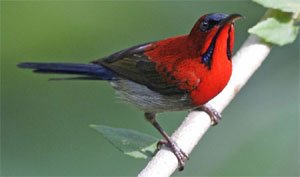
Source: Wikipedia http://www.en.wikipedia.org.
Fig. 189. Aethopyga siparaja.
This family comprises 139 species in 16 genera (Gill and Donsker 2013). Sunbirds are small, often colorful birds of the Old World tropics. They have long, downward-curved bills and feed on nectar like hummingbirds. One genus in this family, Arachnothera, is composed of 13 species of spiderhunters. They are generally not as colorful and feed instead on arachnids and insects (Roberson 2012).
Passeroidea (The Sparrow/Finch kind)

Source: Wikipedia http://www.en.wikipedia.org.
Fig. 190. Zonotrichia atricapilla.
Passeroidea is a superfamily designation for the Old World sparrows (Passeridae) and other families that are considered related to them. In Sibley and Monroe (1990) it includes a number of families already listed here separately. It is used in this work to include the families listed from Passeridae through Cardinalidae in the current IOC World Bird List (Gill and Donsker 2013). Sibley and Monroe (1990) have these listed in two expanded families: Passeridae and Fringillidae.
Wood (2008) used statistical baraminology methods on two datasets focusing on different subfamilies of Fringillidae. In the analysis he noted that there was a failure to detect discontinuity with the outgroups, which were from Passeridae and Estrildidae. He suggested two possibilities: that there was a true lack of discontinuity because all three families were part of a larger holobaramin, or there had been spurious character sampling. He noted that the dataset with a broader sampling of characters (craniomandibular, postcranial, and plumage/integumentary) failed to show positive correlation between ingroup and outgroup. On the other hand, the dataset deemed less holistic showed extensive positive correlation.
There is extensive hybridization data between genera and families in these familiar birds (McCarthy 2006). Based on this data, a large monobaramin (group belonging to one created kind) was identified (Lightner 2010). It includes Old World sparrows and snowfinches (Passeridae), weaver finches (Ploceidae), waxbills, munias and allies (Estrildidae), finches (Fringillidae), oropendolas, orioles, and blackbirds (Icteridae), buntings, New World sparrows and allies (Emberizidae), tanagers and allies (Thraupidae), and cardinals, grosbeaks and allies (Cardinalidae). In these families alone there are 1241 species! So Wood’s (2008) initial suggestion appears to be the case.
When the other families in this range are included, the total number of species rises to 1471. It is logical to include these families because they are considered related to the birds that have hybridized. Based on the taxonomy of Sibley and Monroe (1990), the hybrids span two families. From a creationist standpoint that is evidence that all members of those families would be related, that is, considered a monobaramin. In the IOC World Bird List (Gill and Donsker 2013) these other families appear between the families connected by hybrid data. Again, their position there suggests they are related.
Analysis of Interesting Patterns
In identifying the putative Ark kinds, the cognitum approach proved to be very difficult to use at times, especially in the huge order Passeriformes. This probably should have been anticipated given that bird taxonomy is often controversial and has experienced considerable upheaval since molecular data has become available. Often similar traits appear in unrelated taxa and are explained by convergent evolution.
There are several groups of well-studied birds where considerable hybrid data is available. Three are particularly notable: Anatidae, Galliformes, and the Passeroidea. Anatidae comprises 172 species of ducks, geese, and swans. This family is familiar to many people and provides the average person a glimpse of the amount of diversity that has arisen within an avian kind.
The order Galliformes, which includes chickens, turkeys, quail, and pheasants, is even more impressive. Here the hybrid data connects a whole order with nearly 300 species! Even more surprising is the fact that Sibley and Monroe (1990) place these species in two separate orders based on DNA-DNA hybridization studies! This certainly indicates that a tremendous amount of diversity, both in physical appearance and genetics, has arisen in this kind.
However, perhaps the most astounding group identified based on interspecific hybrid data is Passeroidea. Encompassing Old and New World sparrows, various finches and related birds, this represents an amazing amount of variety in the nearly 1500 species. It is clear that this diversity didn’t arise since the Flood by the standard naturalistic explanations of neo-Darwinism, that is, chance mutations and natural selection (Lightner 2013)!
Each of these three groups (Anatidae, Galliformes and Passeroidea) has a global distribution (Gill and Donsker 2013). This is remarkably consistent with the blessing God pronounced on birds the day they were created (Genesis 1:20–23). We certainly see that they have reproduced and filled the earth. What an awesome testimony to our Creator who provides for His creatures!
It seems as though the diversity within bird kinds may generally be much greater than that within mammals. Perhaps the reason for this is suggested in the Flood account. Two of each kind of land and flying animal were to be taken on the Ark (Genesis 6:19–20). Yet in the case of clean animals, more were taken (Genesis 7:2). The statement in Genesis 7:3 may hint that most birds were clean; meaning a greater amount of genetic diversity may have been present among them on the Ark. Discussion of clean and unclean animals seems consistent with this. Clean animals consist of ruminants; a small group of mammals. In contrast, unclean birds are specifically mentioned in a short list (Leviticus 11; Deuteronomy 14), thus suggesting there were fewer unclean birds relative to clean ones.
The patterns seen do not fit well in the neo-Darwinian tree of life. Instead, there are an enormous number of traits that must be considered the result of convergent evolution rather than common ancestry. According to the neo-Darwinian model, morphologic, physiologic, and molecular traits should be consistent in where they suggest the bird is placed. Unfortunately for the evolutionist, this is often not the case. It is a little harder to predict what we should expect in the creation model. We recognize that similarities and differences may also have been designed. This is in addition to similarity sometimes being from common ancestry (within a kind) or changes producing similar results (aka convergent evolution).
Within a biblical framework, there are many details to sort out. How reliable is the cognitum approach when you have Malagasy warblers (Bernieridae) which includes genera that were initially placed in different families? It is only the advent of molecular data that produced evidence that they belong together? Then again, how valuable is the molecular data in determining relationships? In Sibley and Monroe (1990) the taxonomic level was related to the indirect measurement of DNA similarity. In a biblical framework, do we want to assume that genetic diversity is essentially equivalent within each of the created kinds? Perhaps not.
The idea that the family is the typical level of the kind is challenged by some of the findings here. Perhaps it is higher in even more cases than the hybrid data indicates. If so, this may explain the conundrum with the Malagasy warblers. Perhaps they are also related to the other families these species were once allied with. Yet there needs to be more evidence to support such a conjecture. Considerable research needs to be done to evaluate the types of diversity typical within kinds and suggest the type of differences that may help delimit the boundaries of a kind. The field of baraminology is ripe for harvest. Pray that we would have researchers raised up for the task.
Conclusions
In this survey, 196 “kinds” of birds were identified. While hybrid data was used where it was available, and the cognitum and other data were considered, many kinds were identified by equating the currently recognized family with a kind. This is overly simplistic. Further, bird taxonomy is still in a state of flux, so this should be considered only a rough, conservative estimate.
There are many unanswered questions at this point. We still need to further assess diversity within kinds identified by hybrid data. This will help us understand what characteristics God designed to vary to enable birds to fill the earth. Hopefully this will suggest parameters for delimiting the kinds. Thus there is plenty of room for more exciting research to better understand how our magnificent Creator designed and provides for His Creation.
References
Alderfer, J., ed. 2005. National Geographic Complete Birds of North America. Washington, DC: National Geographic.
Cholewiak, D. 2003a. Rheidae. Animal diversity web. Retrieved from http://animaldiversity.ummz.umich.edu/site/accounts/information/Rheidae.html on August 29, 2012.
Cholewiak, D. 2003b. Casuariidae. Animal diversity web. Retrieved from http://animaldiversity.ummz.umich.edu/site/accounts/information/Casuariidae.html on August 29, 2012.
Cholewiak, D. 2003c. Tytonidae. Animal diversity web. Retrieved from http://animaldiversity.ummz.umich.edu/accounts/Tytonidae/ on March 5, 2013.
Gill, F. and D. Donsker, eds. 2012a. IOC world bird names (v 3.1). Retrieved from http://www.worldbirdnames.org on August 22, 2012 through September 15, 2012.
Gill, F. and D. Donsker, eds. 2012b. IOC world bird names (v 3.2). Retrieved from http://www.worldbirdnames.org on October 18, 2012 through January 28, 2013].
Gill, F. and D Donsker, eds. 2013. IOC world bird names (v 3.3, 3.4). Retrieved from http://www.worldbirdnames.org on January 31, 2013 through September 7, 2013.
Handbook of the birds of the world alive. n.d. Retrieved from http://www.hbw.com/ on August 13, 2013 through September 18, 2013.
Hennigan, T. 2013a. An initial estimate toward identifying and numbering amphibian kinds within the orders Caudata and Gymnophiona. Answers Research Journal 6:17–34. Retrieved from http://www.answersingenesis.org/articles/arj/v6/n1/amphibian-kinds.
Hennigan, T. 2013b. An initial estimate toward identifying and number the frog kinds on the Ark: Order Anura. Answers Research Journal 6:335–365. Retrieved from http://www.answersingenesis.org/articles/arj/v6/n1/frog-kinds-on-ark.
Howard, L. 2003a. Tinamiformes. Animal diversity web. Retrieved from http://animaldiversity.ummz.umich.edu/site/accounts/information/Tinamiformes.html on August 22, 2012.
Howard, L. 2003b. Anhimidae. Animal diversity web. Retrieved from http://animaldiversity.ummz.umich.edu/site/accounts/information/Anhimidae.html on August 29, 2012.
Howard, L. 2003c. Anatidae. Animal diversity web. Retrieved from http://animaldiversity.ummz.umich.edu/site/accounts/information/Anatidae.html on August 29, 2012.
Lightner, J. K. 2010. Identification of a large sparrow-finch monobaramin in perching birds (Aves: Passeriformes). Journal of Creation 24, no. 3:117–121.
Lightner, J. K., T. Hennigan, and G. Purdom. 2011. Determining the Ark kinds. Answers Research Journal 4:195–201. Retrieved from http://www.answersingenesis.org/articles/arj/v4/n1/ark-kinds-flood-baraminology-cognitum.
Lightner, J. K. 2012. Mammalian Ark kinds. Answers Research Journal 5:151–204. Retrieved from http://www.answersingenesis.org/articles/arj/v5/n1/mammalian-ark-kinds.
Lightner, J. K. 2013. Meiotic recombination—designed for inducing genomic change. Journal of Creation 27, no. 1:7–9.
McCarthy, E. M. 2006. Handbook of avian hybrids of the world. New York, New York: Oxford University Press.
McConnachie, M. and T. R. Brophy. 2008. A baraminological analysis of the landfowl (Aves:Galliformes). Occasional Papers of the BSG 11:9–10.
McKilligan, N. 2005. Herons, egrets, and bitterns: Their biology and conservation in Australia. Victoria, Australia: CSIRO Publishing.
Moyle, R. G., M. J. Andersen, C. H. Oliveros, F. D. Steinheimer, and S. Reddy. 2012. Phylogeny and biogeography of the core Babblers (Aves: Timaliidae). Systematic Biology 61, no. 4:631–651.
Roberson, D. 2012. Bird families of the world. 11th and 12th ed. Retrieved from http://creagrus.home.montereybay.com/list.html on August 2012 through September 2013.
Sibley, C.G. and B.L. Monroe. 1990. Distribution and Taxonomy of Birds of the World. New Haven: Yale University Press.
Wetmore, A. 1930. A systematic classification for the birds of the world. Proceedings of the United States National Museum 76:1–8. Retrieved from https://archive.org/details/systematicclassi30wetm
Wilber, R. 2008. Anseranas semipalmata. Animal diversity web. Retrieved from http://animaldiversity.ummz.umich.edu/site/accounts/information/Anseranas_semipalmata.html on August 29, 2012.
Wood, T. 2008. Animal and plant baramins. Eugene, Oregon: Wipf & Stock.















